Intel 18265NG Intel Tri Band Wireless-AC 18265 User Manual Intel Wireless Gigabit v2 6
Intel Mobile Communications Intel Tri Band Wireless-AC 18265 Intel Wireless Gigabit v2 6
Intel >
Contents
- 1. User Manual Regulatory Guide
- 2. User Manual
User Manual

Document Number: 537178-3.9
Intel® Wireless Gigabit v2.6
User Guide
May 2016
Revision 3.9
Intel Confidential

Intel® Wireless Gigabit v2.6
User Guide May 2016
2 Intel Confidential Document Number: 537178-3.9
Notice: This document contains information on products in the design phase of development. The information here is subject to
change without notice. Do not finalize a design with this information.
INFORMATION IN THIS DOCUMENT IS PROVIDED IN CONNECTION WITH INTEL PRODUCTS. NO LICENSE, EXPRESS OR IMPLIED,
BY ESTOPPEL OR OTHERWISE, TO ANY INTELLECTUAL PROPERTY RIGHTS IS GRANTED BY THIS DOCUMENT. EXCEPT AS
PROVIDED IN INTEL’S TERMS AND CONDITIONS OF SALE FOR SUCH PRODUCTS, INTEL ASSUMES NO LIABILITY WHATSOEVER
AND INTEL DISCLAIMS ANY EXPRESS OR IMPLIED WARRANTY, RELATING TO SALE AND/OR USE OF INTEL PRODUCTS INCLUDING
LIABILITY OR WARRANTIES RELATING TO FITNESS FOR A PARTICULAR PURPOSE, MERCHANTABILITY, OR INFRINGEMENT OF ANY
PATENT, COPYRIGHT OR OTHER INTELLECTUAL PROPERTY RIGHT.
A "Mission Critical Application" is any application in which failure of the Intel Product could result, directly or indirectly, in personal
injury or death. SHOULD YOU PURCHASE OR USE INTEL’S PRODUCTS FOR ANY SUCH MISSION CRITICAL APPLICATION, YOU
SHALL INDEMNIFY AND HOLD INTEL AND ITS SUBSIDIARIES, SUBCONTRACTORS AND AFFILIATES, AND THE DIRECTORS,
OFFICERS, AND EMPLOYEES OF EACH, HARMLESS AGAINST ALL CLAIMS COSTS, DAMAGES, AND EXPENSES AND REASONABLE
ATTORNEYS' FEES ARISING OUT OF, DIRECTLY OR INDIRECTLY, ANY CLAIM OF PRODUCT LIABILITY, PERSONAL INJURY, OR
DEATH ARISING IN ANY WAY OUT OF SUCH MISSION CRITICAL APPLICATION, WHETHER OR NOT INTEL OR ITS SUBCONTRACTOR
WAS NEGLIGENT IN THE DESIGN, MANUFACTURE, OR WARNING OF THE INTEL PRODUCT OR ANY OF ITS PARTS.
Intel may make changes to specifications and product descriptions at any time, without notice. Designers must not rely on the
absence or characteristics of any features or instructions marked “reserved” or “undefined.” Intel reserves these for future
definition and shall have no responsibility whatsoever for conflicts or incompatibilities arising from future changes to them. The
information here is subject to change without notice. Do not finalize a design with this information.
Intel software products are copyrighted by and shall remain the property of Intel Corporation. Use, duplication, or disclosure is
subject to restrictions stated in Intel’s Software License Agreement, or in the case of software delivered to the government, in
accordance with the software license agreement as defined in FAR 52.227-7013.
The products described in this document may contain design defects or errors known as errata which may cause the product to
deviate from published specifications. Current characterized errata are available on request.
The code names presented in this document are only for use by Intel to identify products, technologies, or services in development
that have not been made commercially available to the public, i.e., announced, launched, or shipped. They are not "commercial"
names for products or services and are not intended to function as trademarks.
Contact your local Intel sales office or your distributor to obtain the latest specifications and before placing your product order.
Copies of documents which have an order number and are referenced in this document, or other Intel literature may be obtained by
calling 1-800-548-4725 or by visiting Intel’s website at http://www.intel.com/design/literature.htm.
Intel is a trademark of Intel Corporation or in the US and other countries.
* Other brands and names may be claimed as the property of others.
Copyright © 2016 Intel Corporation. All rights reserved.

Intel® Wireless Gigabit v2.6
May 2016 User Guide
Document Number: 537178-3.9 Intel Confidential 3
Contents
1 Introduction ................................................................................................................. 8
1.1 Scope ................................................................................................................. 8
1.2 References .......................................................................................................... 8
1.3 Wireless docking .................................................................................................. 8
1.3.1 “Place to Dock, Snap to Go” experience .................................................. 8
1.3.2 Wireless Docking (WiDock) and Wireless Display (WiDi) ............................ 8
1.3.3 Wireless peripheral .............................................................................. 9
1.4 Key features ........................................................................................................ 9
1.5 SW and HW deliverables ........................................................................................ 9
1.6 Notebook platform preparations for WiDock ............................................................. 9
1.7 Known limitations ................................................................................................. 9
2 Software Install .......................................................................................................... 10
2.1 NB-side installation .............................................................................................. 10
3 WiGig Application User Manual for Windows 7*/8*/8.1* ........................................... 13
3.1 User manual ....................................................................................................... 13
3.1.1 Launch the Intel® Wireless Dock Manager .............................................. 13
3.1.2 Make the first connection ..................................................................... 13
3.1.3 Automatic connection default ............................................................... 16
3.1.4 Automatic connections ......................................................................... 17
3.1.5 Manually connect to a dock .................................................................. 17
3.1.6 Automatic connection in S3 (depends on BIOS configuration) ................... 18
3.1.7 Automatic connection in connected standby ........................................... 18
3.1.8 Disconnect from the dock .................................................................... 19
3.1.9 PIN-based pairing ............................................................................... 21
3.1.10 Disable and enable WiGig ..................................................................... 22
3.2 Change dock settings ........................................................................................... 23
3.3 Dock software update .......................................................................................... 25
3.3.1 Update during connection .................................................................... 25
3.4 Diagnostic information ......................................................................................... 27
3.4.1 Details ............................................................................................... 28
3.5 Manage docks ..................................................................................................... 29
3.6 Notification messages .......................................................................................... 31
3.6.1 Unable to Connect............................................................................... 31
3.6.2 No Available Docks Found .................................................................... 31
3.6.3 Weak Connection ................................................................................ 32
3.6.4 WiGig is Not Working........................................................................... 32
3.6.5 WiGig disabled: critical temperature ...................................................... 34
3.6.6 WiGig disabled by hardware RF kill switch .............................................. 34
3.6.7 WiGig disabled by airplane mode .......................................................... 35
4 WiGig Application User Manual for Windows 10* ....................................................... 36
4.1 User manual ....................................................................................................... 36
4.1.1 Launch the Intel® Wireless Dock Manager .............................................. 36
4.1.2 Make the first connection ..................................................................... 36
4.1.3 Automatic connection default ............................................................... 41
4.1.4 Automatic connections ......................................................................... 41
4.1.5 Manually connect to a dock .................................................................. 42
4.1.6 Automatic connection in S3 (depends on BIOS configuration) ................... 42
4.1.7 Automatic connection in connected standby ........................................... 42
4.1.8 Disconnect from the dock .................................................................... 43
4.1.9 PIN-based pairing ............................................................................... 43

Intel® Wireless Gigabit v2.6
User Guide May 2016
4 Intel Confidential Document Number: 537178-3.9
4.1.10 Disable and enable WiGig ..................................................................... 43
4.2 Change dock settings ........................................................................................... 43
4.3 Dock software update .......................................................................................... 43
4.4 Diagnostic information ......................................................................................... 44
4.5 Manage docks ..................................................................................................... 44
4.6 Notification messages .......................................................................................... 45
4.6.1 Not found .......................................................................................... 45
4.6.2 Try connecting your device again .......................................................... 46
4.6.3 Couldn’t connect ................................................................................. 47
4.6.4 Weak connection ................................................................................ 47
4.6.5 WiGig disabled: critical temperature ...................................................... 48
4.6.6 WiGig is Not Working........................................................................... 49
5 The Wireless Dock and Multiple Displays .................................................................... 50
5.1 Intel® WiGig A/V wireless capabilities ..................................................................... 50
5.1.1 Intel® WiGig DisplayPort Bandwidth and other limitations ........................ 50
5.2 User experience when connecting more than two displays to the wireless dock ........... 50
6 WiGig events in Windows Event Viewer ...................................................................... 53
6.1 WiGig Event Properties ......................................................................................... 53
6.2 WiGig Event Data ................................................................................................ 53
6.3 Accessing WiGig Events Log .................................................................................. 53

Intel® Wireless Gigabit v2.6
May 2016 User Guide
Document Number: 537178-3.9 Intel Confidential 5
Figures
Figure 1-1 WiDock use models ............................................................................................ 9
Figure 2-1 End User License Agreement dialog box ...............................................................10
Figure 2-2 Success message ..............................................................................................10
Figure 2-3 Windows security message ................................................................................11
Figure 2-4 Product Improvement Program dialog box ...........................................................11
Figure 2-5 Changing Intel® Product Improvement Program selection ......................................12
Figure 3-1 Tray icon indications .........................................................................................13
Figure 3-2 Welcome OSD message .....................................................................................14
Figure 3-3 Dock select ......................................................................................................14
Figure 3-4 Dock confirmation message ...............................................................................15
Figure 3-5 Dock confirmation OSD .....................................................................................15
Figure 3-6 Dock connected message ...................................................................................16
Figure 3-7 Automatically Connect to this Dock message ........................................................16
Figure 3-8 Disabling the auto-connect setting ......................................................................17
Figure 3-9 Manual dock connection .....................................................................................18
Figure 3-10 Dock disconnection mesage ...............................................................................19
Figure 3-11 Manual disconnect option ...................................................................................20
Figure 3-12 Ready to connect message .................................................................................20
Figure 3-13 Enabling PIN-based pairing ................................................................................21
Figure 3-14 PIN-based pairing in OSD ..................................................................................22
Figure 3-14 Disable WiGig using the gear icon .......................................................................22
Figure 3-15 Disable WiGig warning message .........................................................................23
Figure 3-16 WiGig disabled confirmation message ..................................................................23
Figure 3-17 Dock Management button ..................................................................................24
Figure 3-18 Dock management dialog box ............................................................................24
Figure 3-19 Dock software Update Required message .............................................................26
Figure 3-20 OSD Update Required message ..........................................................................26
Figure 3-21 Dock update progress .......................................................................................27
Figure 3-22 OSD update progress message ...........................................................................27
Figure 3-23 Advanced diagnostics window .............................................................................28
Figure 3-24 Choosing Manage Remembered Docks .................................................................30
Figure 3-25 Manage Remembered Docks auto-connect feature ................................................30
Figure 3-26 Unable to Connect message ...............................................................................31
Figure 3-27 No Available Docks Found message .....................................................................31
Figure 3-28 Weak Connection message .................................................................................32
Figure 3-29 WiGig is Not Working message (with example error code 0x1000) ..........................32
Figure 3-30 WiGig disabled due to overheating message .........................................................34
Figure 3-31 WiGig disabled by hardware RF kill switch message ...............................................34
Figure 3-32 WiGig disabled by airplane mode message ...........................................................35
Figure 4-1 Welcome OSD message .....................................................................................37
Figure 4-2 Network & Internet page showing Airplane mode settings ......................................37
Figure 4-3 Action Center link .............................................................................................38
Figure 4-4 Connect pane ...................................................................................................38
Figure 4-5 Connect pane during connecting stage ................................................................39
Figure 4-6 Connect OSD message ......................................................................................40
Figure 4-7 Dock connected message ...................................................................................40
Figure 4-8 Dock connected OSD message ...........................................................................41
Figure 4-9 Disable the auto connect setting .........................................................................42
Figure 4-10 WiGig disabled confirmation message ..................................................................43
Figure 4-11 Dock update required toast ................................................................................44

Intel® Wireless Gigabit v2.6
User Guide May 2016
6 Intel Confidential Document Number: 537178-3.9
Figure 4-12 Remove device button .......................................................................................44
Figure 4-13 Remove device approval dialog box.....................................................................45
Figure 4-14 Device not found message .................................................................................45
Figure 4-15 Try connecting your device again message ..........................................................46
Figure 4-16 Couldn’t connect message .................................................................................47
Figure 4-17 Weak connection toast ......................................................................................48
Figure 4-18 Weak connection message in Dock Manager .........................................................48
Figure 4-19 WiGig disabled due to overheating toast ..............................................................48
Figure 4-20 WiGig disabled due to overheating message in Dock Manager ................................49
Figure 5-1 DisplayPort topology viewer ...............................................................................51
Figure 5-2 Windows Screen Resolution control panel ............................................................52
Figure 5-3 Graphics control panel .......................................................................................52
Tables
Table 1–1 References ........................................................................................................ 8
Table 3–1 Error code cases and possible recovery methods ..................................................33
Table 6–1 List of groups for Task Category parameter in WiGig Events ...................................53

Intel® Wireless Gigabit v2.6
May 2016 User Guide
Document Number: 537178-3.9 Intel Confidential 7
Revision History
Revision Description Date
1.0 Initial release. May 16, 2013
1.1 Alpha update November 25, 2013
2.0 Beta update April 9, 2014
2.1 Beta 1.5 update June 30, 2014
2.2 Beta 2 update September 11, 2014
2.3 Chapter 2.2 flashing dock instructions October 23, 2014
3.0 PV version updates November 26, 2014
3.1 Added 4.1.1. Maple Peak DisplayPort Bandwidth and other
limitations January 8, 2015
3.2 SW version 2.0 March 30, 2015
3.3 Added win10 user guide August 5, 2015
3.4 Update sections 1.2 & 3.4 October 27, 2015
3.5 Update Intel Product Improvement Program (chapter 2)
Update to v2.2 December 2, 2015
3.6 Updated welcome screen and no scanning time after disconnect March, 12, 2016
3.7 Added WiGig events in Windows Event Viewer, added Pin based
pairing capability April, 17, 2016
3.8 Update section 3.1.9 May 1, 2016
3.9 Update section 3.1.9 with additional info on PIN based pairing May 10, 2016
§

Introduction
Intel® Wireless Gigabit v2.6
User Guide May 2016
8 Intel Confidential Document Number: 537178-3.9
1 Introduction
This chapter provides an overview of the Intel® Wireless Gigabit (WiGig) solution, which comprises the
Intel® Tri-Band Wireless-AC17265 (Client), Intel® Tri-Band Wireless-AC18265 (Client), the Intel®
Wireless Gigabit Sink W13100 (Dock), and the Intel® Wireless Gigabit Antenna-M 10041/2R
(Antenna).
1.1 Scope
This document familiarizes customers with the Intel® WiGig software (SW) solution components and
provides installation and configuration details.
1.2 References
Table 1–1 References
Document name Description
Ref 1 537180_Maple_Peak_External_Product_Specification
_Rev.3.1 Maple Peak External Product Specifications (EPS)
Ref 2 557654_Maple_Peak_WiGig_SNK_EPS_Rev1.0 Maple Peak WiGig SNK External Product
Specifications (EPS)
Ref 3 557232_WiGig_R-
FEM_External_Product_Specification_Rev1.0 WiGig R-FEM External Product Specifications
(EPS)
Ref 4 553630_Intel_Wireless_Douglas_Peak_and_Pine_Pea
k_EPS_Rev1.0 Douglas Peak and Pine Peak External Product
Specifications (EPS)
Ref 5 545844_Intel_WiGig_Maple_Peak _API_SDK Rev3.0 WiGig SDK Package
Ref 6 557869_Intel_Wireless_Tri-
Band_18260_DgP_WiGig_W11000_PnP_PDG_Rev2.0 Douglas Peak and Pine Peak Platform Design
Guidelines
Ref 7 Intel_Wireless_Gigabit_DFC-
DFB_Tool_User_Guide_Rev3.3 DFC and DFB Tools User Guide
1.3 Wireless docking
The main use of Intel® WiGig at product launch is wireless docking in conjunction with the Maple Peak
SNK.
Wireless docking generally occurs when the user is working 2–4 feet from the display(s). The user
experiences the same kind of responsiveness as operating a workstation/desktop.
1.3.1 “Place to Dock, Snap to Go” experience
Wireless docking is designed to minimize user actions. After the initial WPS-based pairing, the typical
user is able to auto-dock, meaning the device automatically connects to the dock and peripheral when
in range of the dock. In other words, by the time the device is on the desk, it is already docked.
Undocking is as simple, allowing the user to grab the device and walk away.
1.3.2 Wireless Docking (WiDock) and Wireless Display (WiDi)
WiDock differs from other models, such as Miracast* or Intel® Wireless Display, in which the user is
further from the screen (such as on the couch or in a conference room), and is focused on content
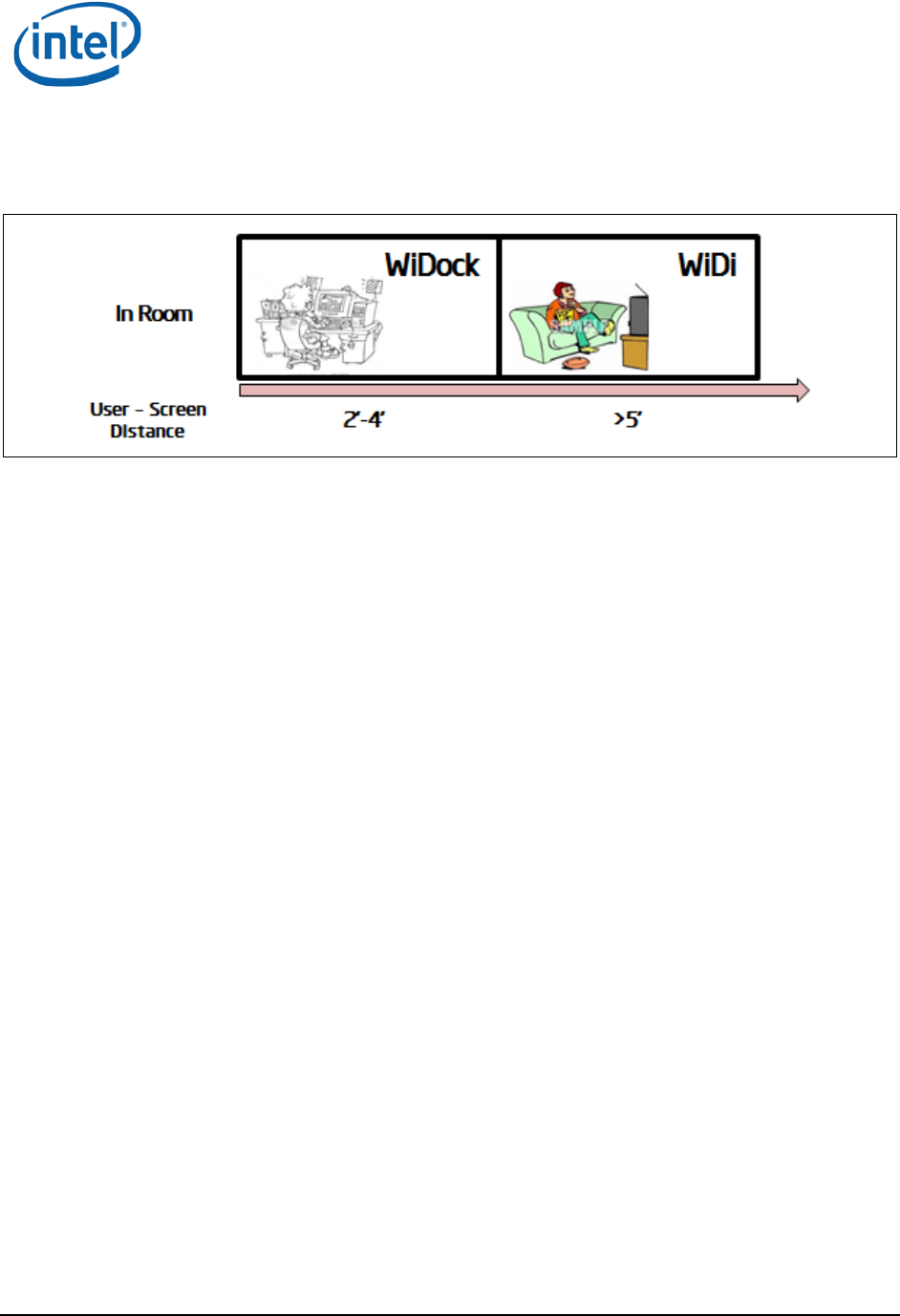
Introduction
Intel® Wireless Gigabit v2.6
May 2016 User Guide
Document Number: 537178-3.9 Intel Confidential 9
consumption (watching a video, sharing a screen with others, gaming) rather than productivity or
content creation.
Figure 1-1 WiDock use models
1.3.3 Wireless peripheral
The wireless peripheral feature allows a device to interact with high-speed USB peripherals over
WiGig. For example, a directly attached storage device equipped with Maple Peak SNK would allow a
high-speed USB 3.0 connection with Intel WiGig equipped tablet or notebook.
When connecting, many of the wireless docking capabilities would be applicable (excluding of course
the display capabilities), allowing USB 3.0 like throughputs (>1 Gbps) for on-desk distances.
1.4 Key features
See Ref 4 (EPS document).
1.5 SW and HW deliverables
See Ref 4 (EPS document).
1.6 Notebook platform preparations for WiDock
Operating system:
– Microsoft Windows 7* 32/64, Microsoft Windows 8.1* U 64, Microsoft Windows 10*
1.7 Known limitations
See Ref 4 (EPS document).
§
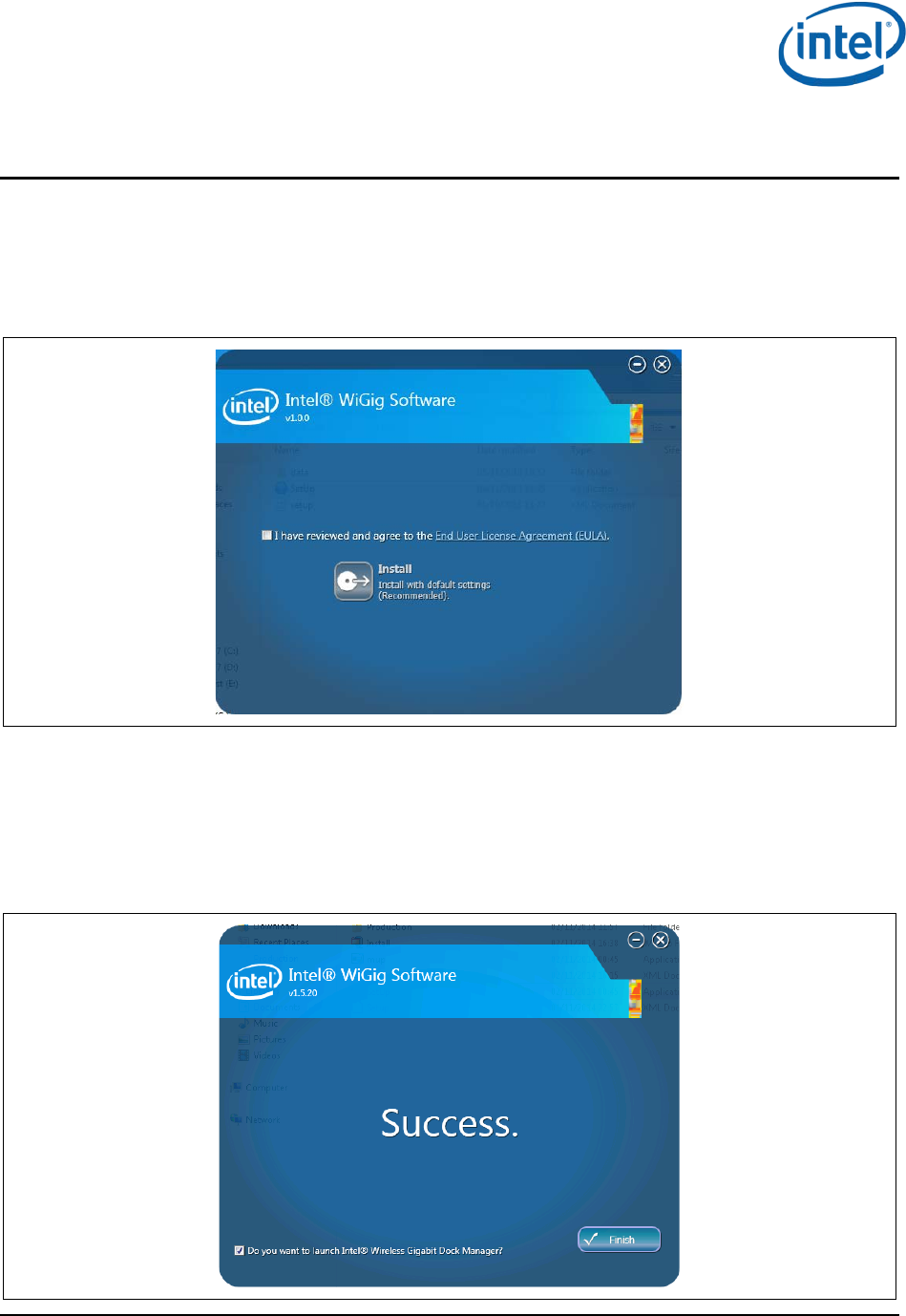
Software Install
Intel® Wireless Gigabit v2.6
User Guide May 2016
10 Intel Confidential Document Number: 537178-3.9
2 Software Install
2.1 NB-side installation
1. Go to G Layout\Win7Plus\ and run Setup.exe.
2. Setup.exe installs the relevant installer for either a 32-bit platform or a 64-bit platform.
Figure 2-1 End User License Agreement dialog box
3. Check the I have reviewed and agree to the EULA box, and click Install. This will install the
operational WiGig software for the NB.
4. When the application is successfully installed, select the Do you want to launch Intel® Wireless
Gigabit Dock Manager? check box. Click Finish.
5. You will be able to launch the Intel® Wireless Dock Manager application from the desktop shortcut
later if you do not select this option.
Figure 2-2 Success message
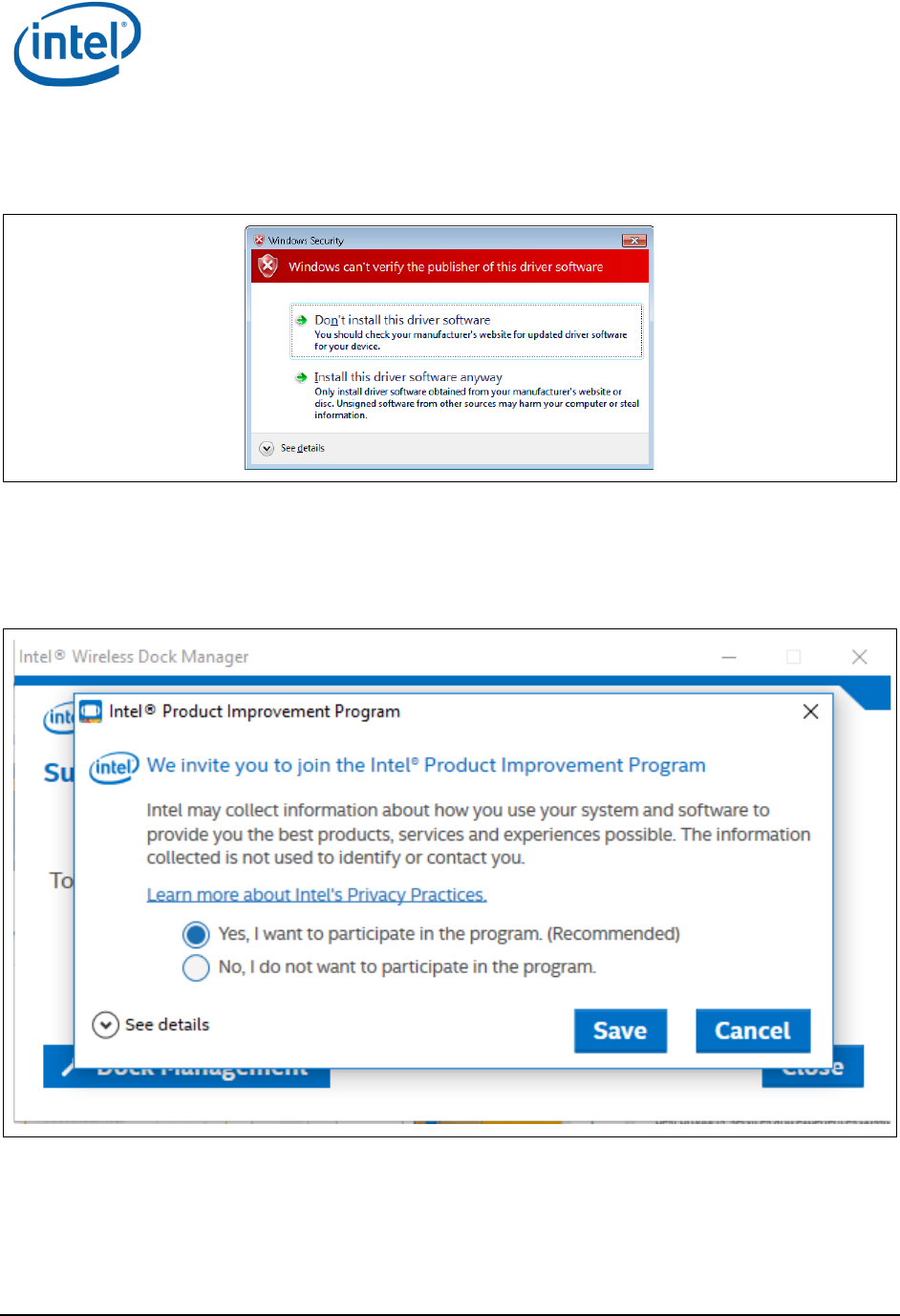
Software Install
Intel® Wireless Gigabit v2.6
May 2016 User Guide
Document Number: 537178-3.9 Intel Confidential 11
6. During the first installation, the device driver is installed. If the Windows Security message shown
in Figure 2-3 appears, choose Install this driver software anyway to continue the installation.
Figure 2-3 Windows security message
To avoid this window, run the certificate file (iCert.spc) from the Certificates layout.
To run the installer in silent mode, run the command setup.exe –q from a command line.
7. By the end of the installation, the user will be asked to participate in the Product Improvement
Program, as shown in Figure 2-4.
Figure 2-4 Product Improvement Program dialog box
8. You may change your selection at any time on the Settings menu of the Intel Wireless Dock
Manager; see Figure 2-5.
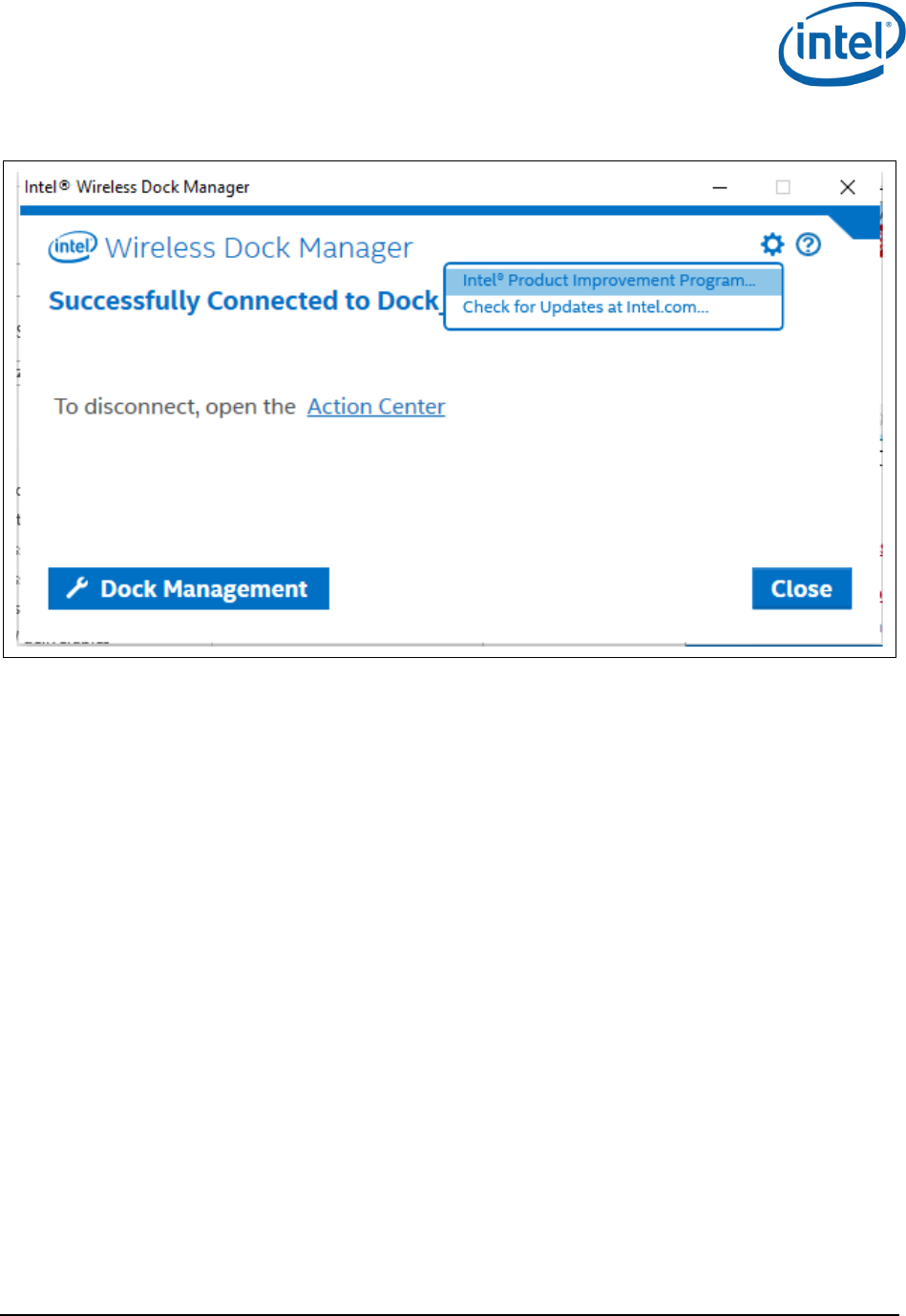
Software Install
Intel® Wireless Gigabit v2.6
User Guide May 2016
12 Intel Confidential Document Number: 537178-3.9
Figure 2-5 Changing Intel® Product Improvement Program selection
§
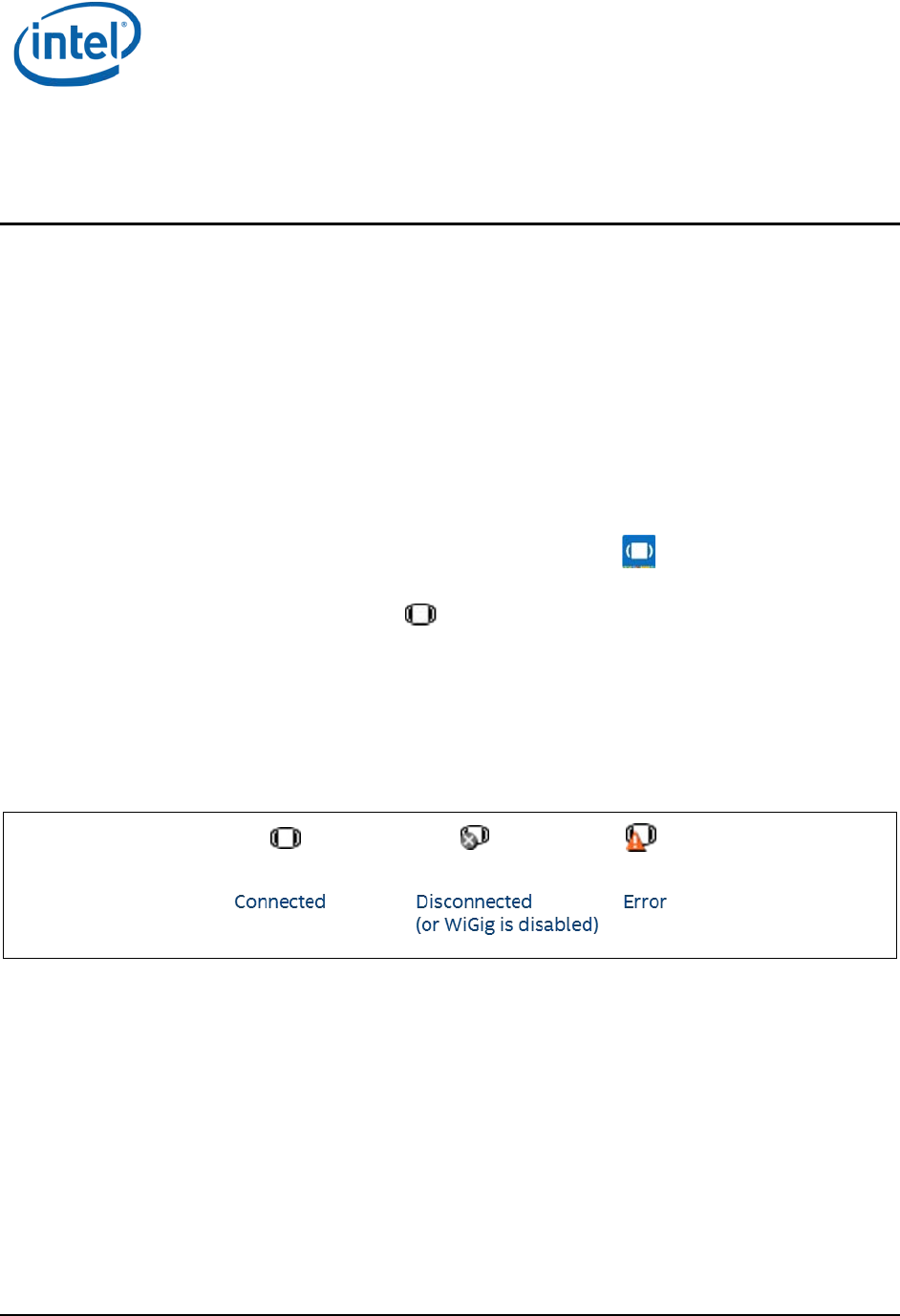
WiGig Application User Manual for Windows 7*/8*/8.1*
Intel® Wireless Gigabit v2.6
May 2016 User Guide
Document Number: 537178-3.9 Intel Confidential 13
3 WiGig Application User Manual for
Windows 7*/8*/8.1*
3.1 User manual
The Intel® Wireless Dock Manager is a dedicated application that runs on the client and allows the
user to find, connect to, and configure docks.
LEDs on the dock, and an on-screen display (OSD) on the monitor connected to the dock, provide
further feedback about the dock status, and assist the user in performing actions.
The activity button on the dock is used in some of the flows (like pairing and
connection/disconnection).
3.1.1 Launch the Intel® Wireless Dock Manager
The Intel® Wireless Dock Manager starts automatically with Windows.
To invoke the Intel® Wireless Dock Manager interface, double-click the icon on the desktop,
labeled Intel® Wireless Dock Manager.
Alternatively, double-click the WiGig tray icon , or right-click and choose View available docks.
A dedicated tray icon can initiate the Intel® Wireless Dock Manager and indicate the relevant status as
shown in Figure 3-1:
Connected: The NB is connected to a dock
Disconnected: The NB is not connected to a dock
Error: Error while connecting or weak connection (hover to see the error reason)
Figure 3-1 Tray icon indications
Note: The Intel® Wireless Dock Manager application keeps running from the system tray even if
you click the X (close window) icon on the application.
3.1.2 Make the first connection
1. Turn on the power on your dock. When the dock is ready to accept connections, the external
monitor will light up and show the welcome OSD message shown in Figure 3-2.
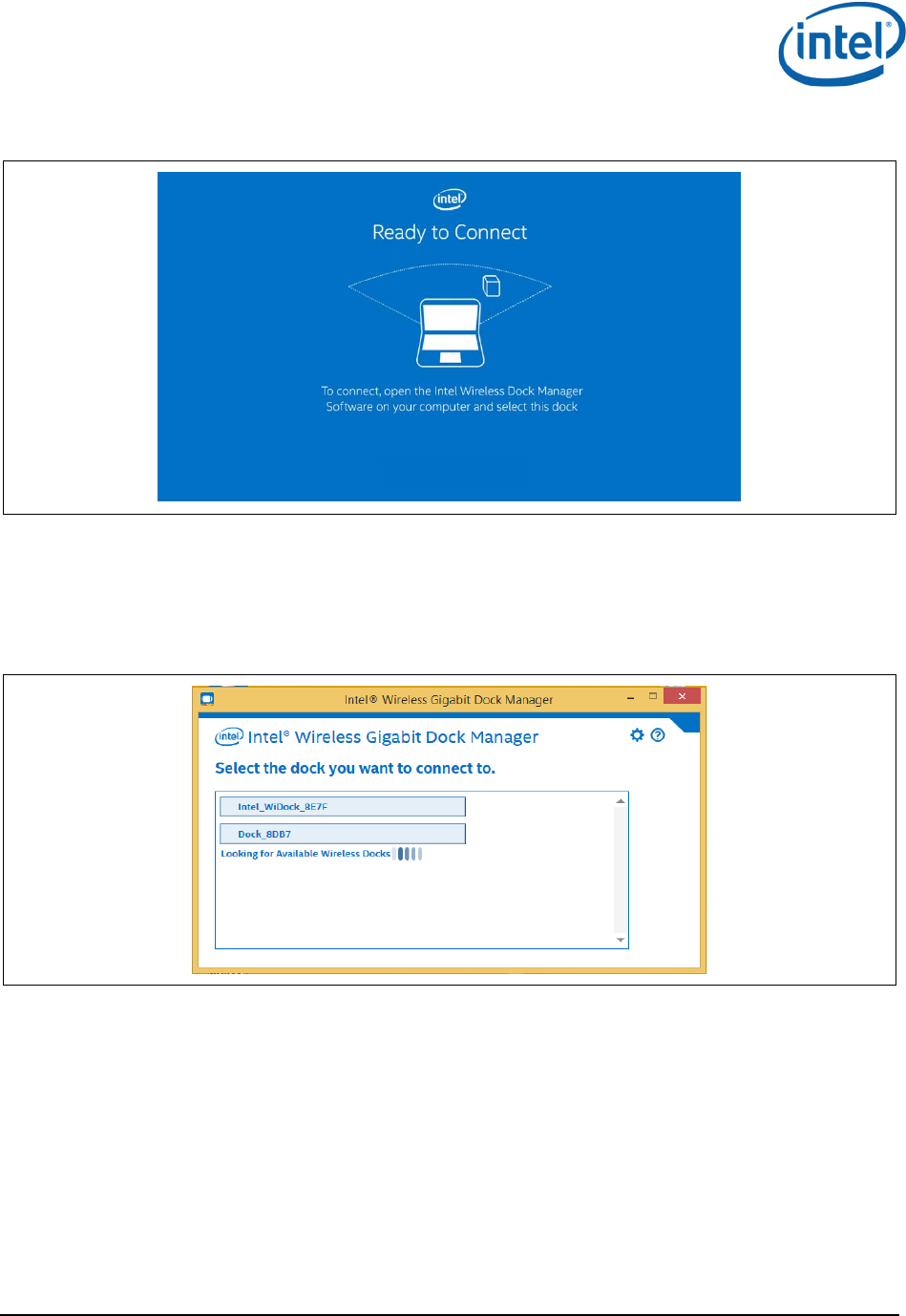
WiGig Application User Manual for Windows 7*/8*/8.1*
Intel® Wireless Gigabit v2.6
User Guide May 2016
14 Intel Confidential Document Number: 537178-3.9
Figure 3-2 Welcome OSD message
2. This screen remains until the connection is made. After a few minutes of inactivity, the monitor
turns off to conserve power. Press the dock activity button to wake up the monitor and continue
with the connection.
3. WiGig will start scanning for docks in your vicinity. You will see a window similar to that shown in
Figure 3-3.
Figure 3-3 Dock select
4. Choose the dock you wish to connect to by clicking it.
Note: Since this is the first time you are connecting to this dock, you will need to pair with it.
Pairing creates a set of authentication keys that uniquely identify your client and dock
pair, and allow them to communicate in a secured, encrypted manner over-the-air.
5. Press the connection button on your dock to confirm it, as indicated in Figure 3-4.
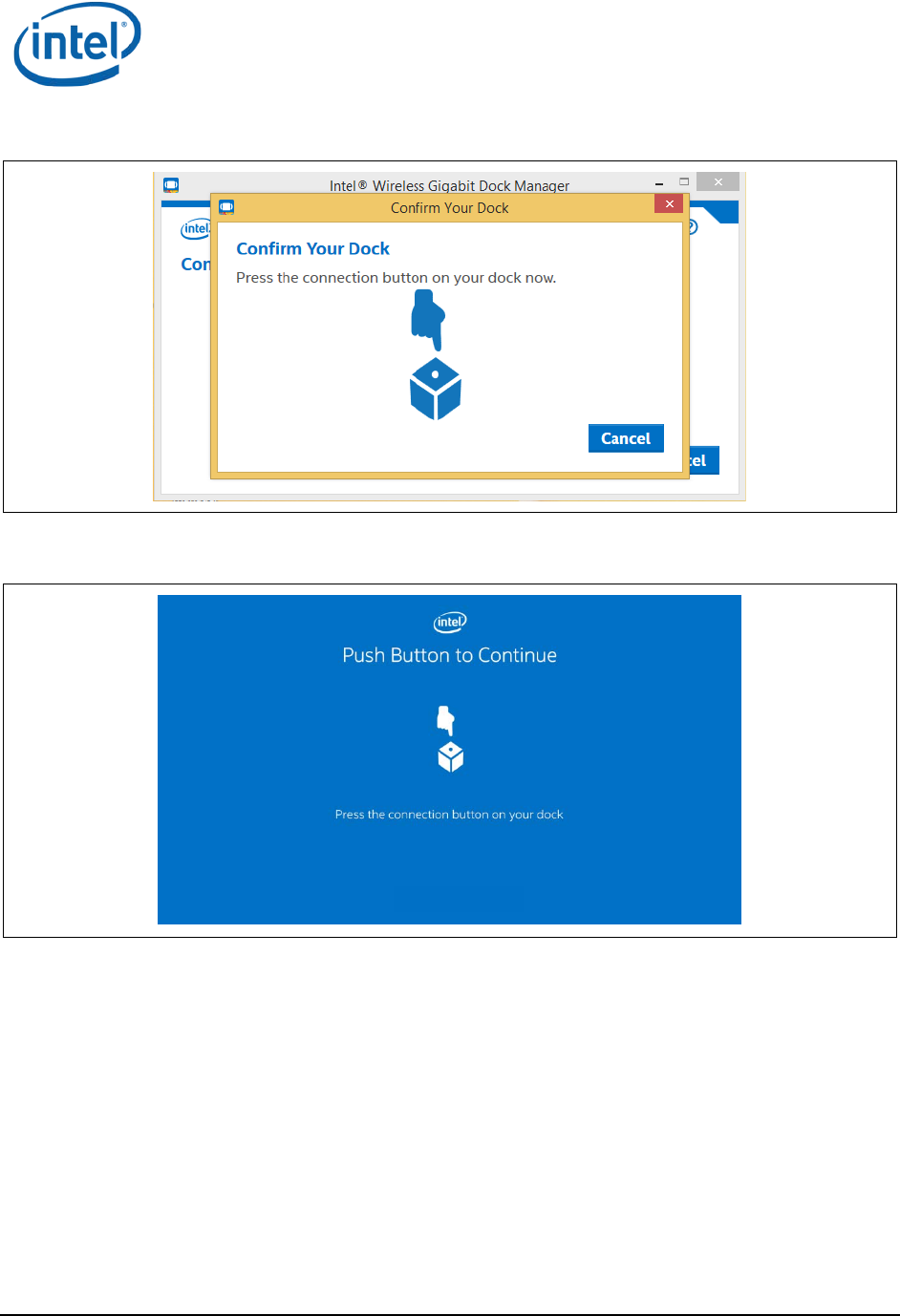
WiGig Application User Manual for Windows 7*/8*/8.1*
Intel® Wireless Gigabit v2.6
May 2016 User Guide
Document Number: 537178-3.9 Intel Confidential 15
Figure 3-4 Dock confirmation message
6. A corresponding OSD will appear on the external monitor, as shown in Figure 3-5.
Figure 3-5 Dock confirmation OSD
7. Press the activity button on the dock to complete the pairing process. The Connected dialog box
appears shortly after, as shown in Figure 3-6.
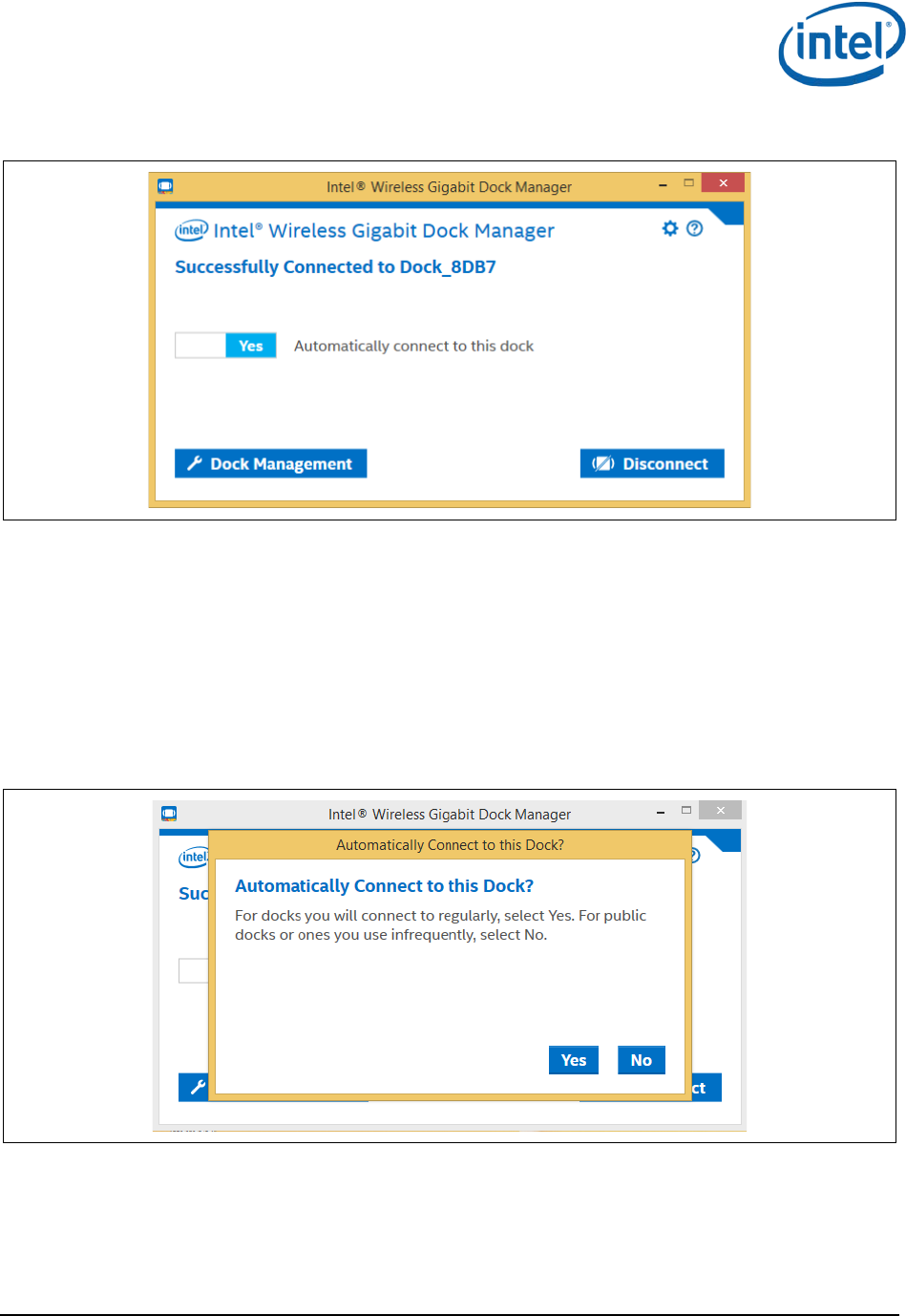
WiGig Application User Manual for Windows 7*/8*/8.1*
Intel® Wireless Gigabit v2.6
User Guide May 2016
16 Intel Confidential Document Number: 537178-3.9
Figure 3-6 Dock connected message
Note: A successful connection is also indicated by the dock LED (if available), and the external
monitor and USB devices being connected and enumerated on your client (you will hear
the Windows hot-plug audio tone cues).
Congratulations! You have made your first wireless docking connection.
3.1.3 Automatic connection default
While connecting to the dock for the first time, you will see the message to set the dock to be
automatically connected or not, as shown in Figure 3-7.
Figure 3-7 Automatically Connect to this Dock message
For docks you connect to regularly, select Yes. For public docks or ones you use rarely, select No.
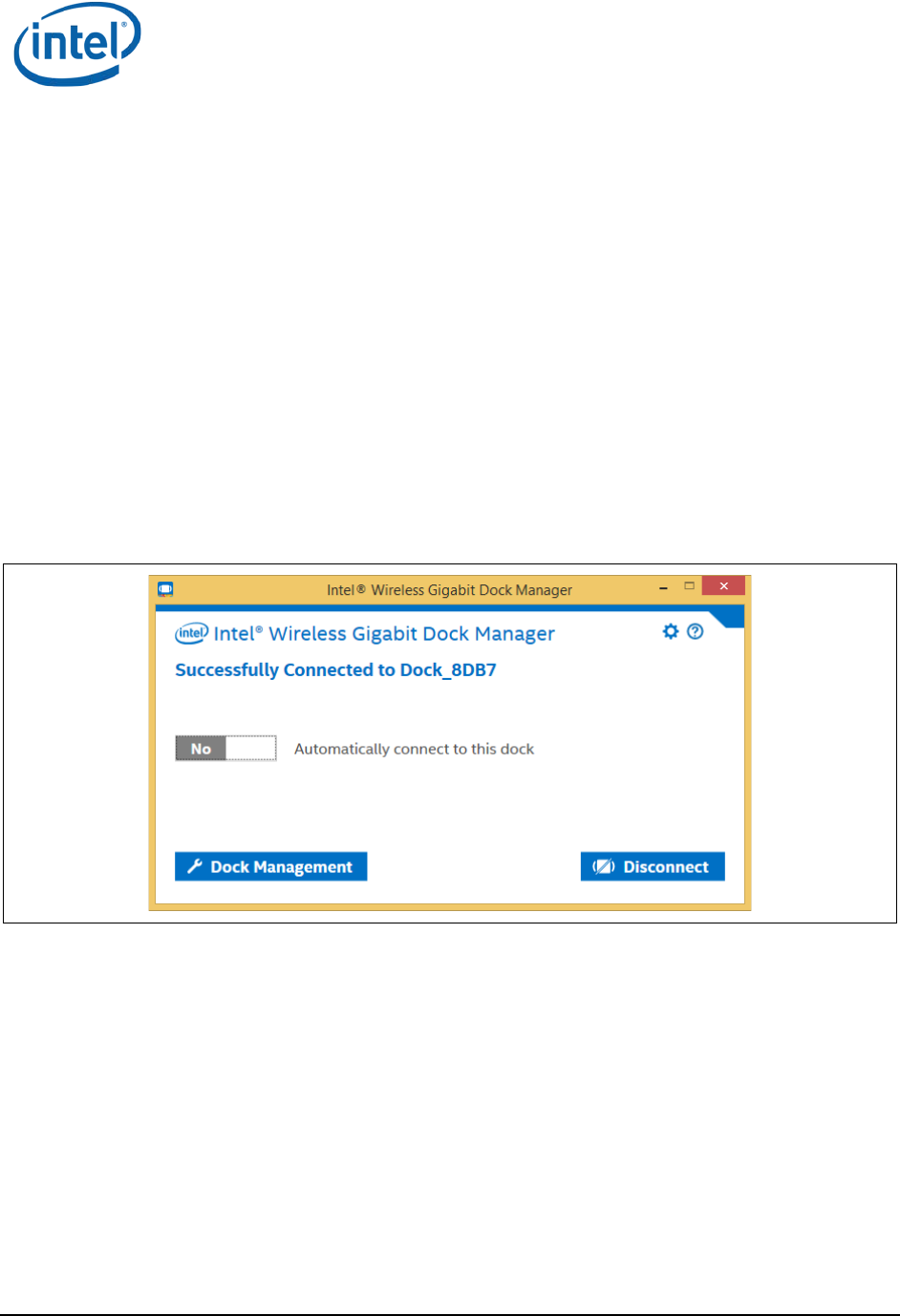
WiGig Application User Manual for Windows 7*/8*/8.1*
Intel® Wireless Gigabit v2.6
May 2016 User Guide
Document Number: 537178-3.9 Intel Confidential 17
3.1.4 Automatic connections
If a dock is set to connect automatically, WiGig will attempt to automatically connect to this dock once
in range. To this end, WiGig keeps scanning in the background, while consuming very little power.
To connect, simply place your client (assumed to be in S0) near the dock. Within several seconds,
WiGig will discover the dock and will connect to it automatically. You do not have to invoke the
Wireless Dock Manager, open the lid or take any action, just wait until the external screen comes up
and USB devices are enumerated, and you can start working.
When successfully connected to a dock, the dock LED changes color (color is specific to dock vendor).
Note: For the connection to be fully completed automatically, as described above, the client
needs to be powered on and active (such as in S0). If the client is in S3, WiGig will
automatically discover the dock, and then you can use the dock button to wake up the
client and complete the docking procedure. See Section 3.1.6 for more details. Ability to
wake up the client from the dock is vendor specific and is configured in the BIOS.
You can disable auto-connect by changing the toggle on the main Wireless Dock Manager screen while
connected, as shown in Figure 3-8.
Figure 3-8 Disabling the auto-connect setting
You can only change a dock between automatic and manual connection when you are actively
connected to the dock.
Once auto-connect is disabled, the client will no longer connect automatically and you will have to
manually select the dock from the client, as described in Section 3.1.5.
3.1.5 Manually connect to a dock
To manually connect to a dock, choose the dock from the list of docks by clicking on it, as shown in
Figure 3-9.
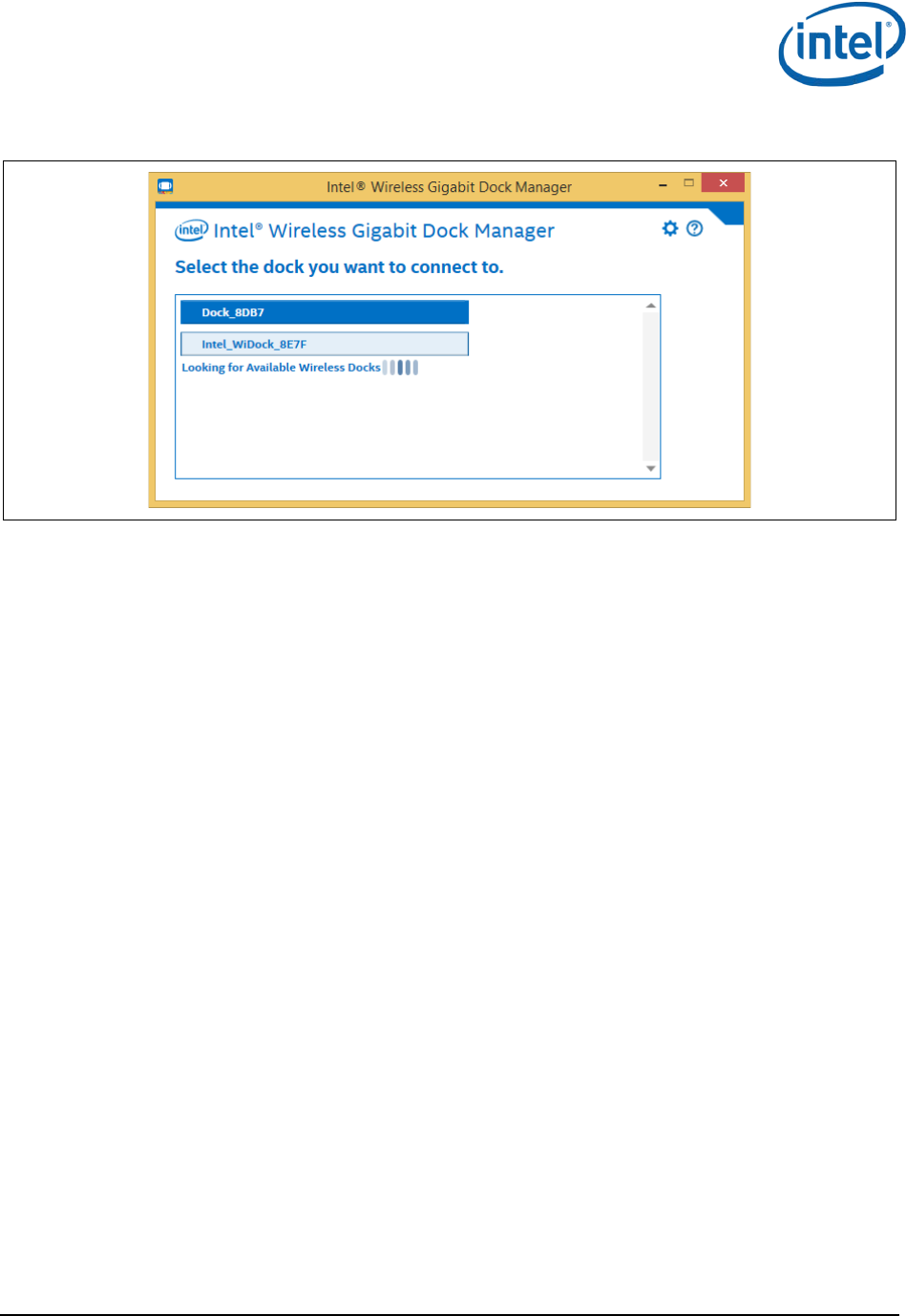
WiGig Application User Manual for Windows 7*/8*/8.1*
Intel® Wireless Gigabit v2.6
User Guide May 2016
18 Intel Confidential Document Number: 537178-3.9
Figure 3-9 Manual dock connection
Docks that you have already paired with in the past will appear with a dark background color. Docks
that you have never paired with will appear with a light background color.
The list is being refreshed automatically, as WiGig keeps scanning in the background.
Another method to connect to a dock is via the tray icon. If there is only a single paired dock in range
(that is, a dock you have already paired with in the past), you can right-click the tray icon and choose
Connect to <dock name>. Right-clicking when there is more than one paired dock in range, or no
paired docks, will give you the option to open the Wireless Dock Manager (View available docks),
where you can choose your desired dock from the list.
When successfully connected to a dock, the dock LED changes color (color is specific to dock vendor).
3.1.6 Automatic connection in S3 (depends on BIOS
configuration)
When getting in range with a paired dock that is set to auto-connect, and the client is sleeping (S3),
the WiGig radio will discover the dock and establish a low power link to it, known as low-power
connected. This mode may be indicated by the LED changing color.
While in this mode, the system is kept in its low power state (S3), and WiGig will wait for an indication
from the dock side to wake up the system and complete the connection procedure. This can be
achieved by pressing the activity button on the dock. When the button is pressed, the client is moved
to S0, and the connection completes automatically.
Once fully connected, the dock LED may change color.
3.1.7 Automatic connection in connected standby
When getting in range with a paired dock that is set to auto-connect, and the client is connected
standby low-power mode, the WiGig radio will automatically connect to the dock. The devices
connected to the dock will be connected and enumerated on the client, however the external monitor
will not come up and the system will remain in connected standby.
To take the system out of connected standby, and light up the screen, press the activity button on the
dock, or alternatively click the mouse or press the keyboard.
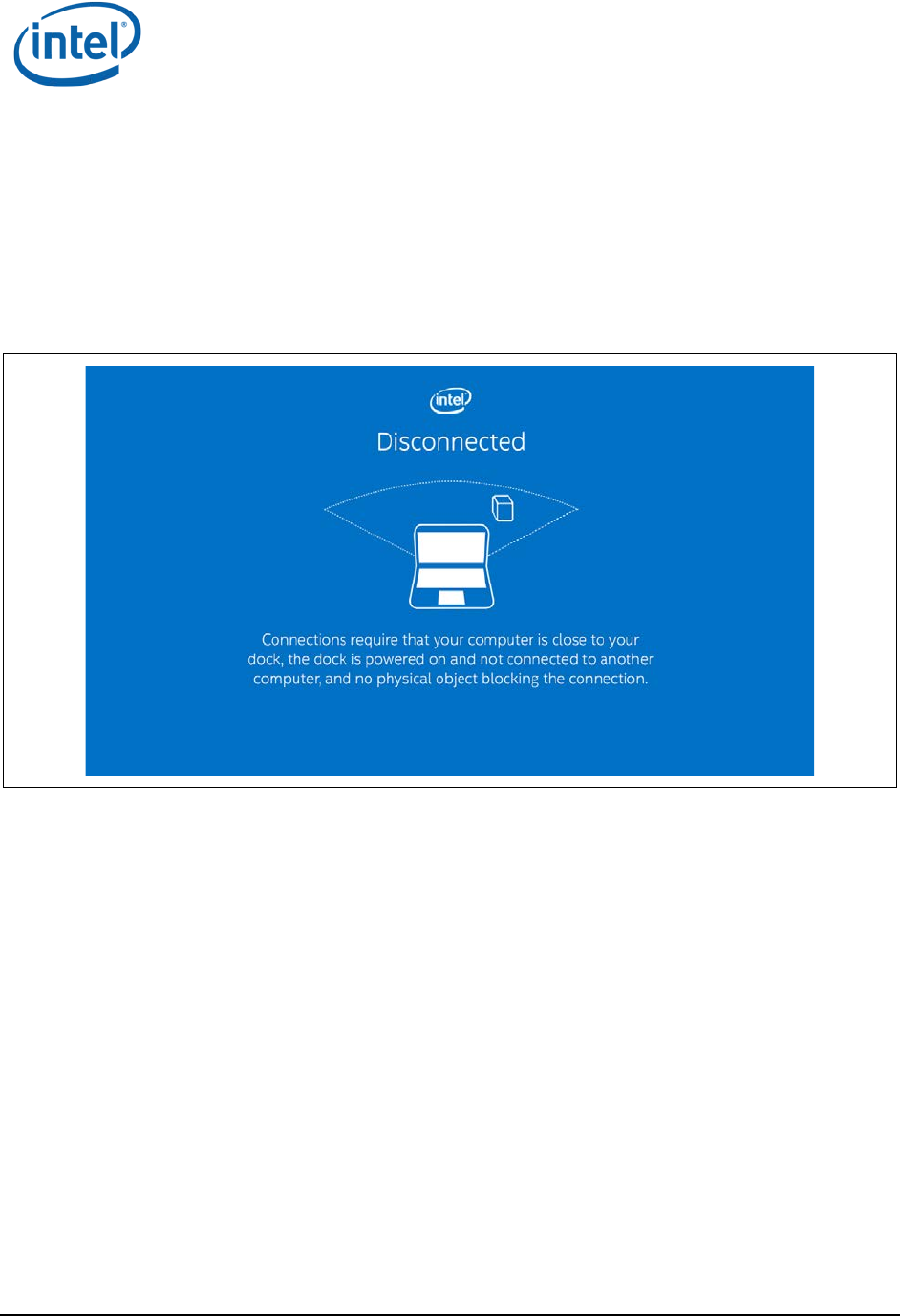
WiGig Application User Manual for Windows 7*/8*/8.1*
Intel® Wireless Gigabit v2.6
May 2016 User Guide
Document Number: 537178-3.9 Intel Confidential 19
3.1.8 Disconnect from the dock
There are several methods in which you can disconnect an active connection:
1. First, you can simply take your client and walk out of range from the dock. WiGig will eventually
lose the link, and the dock will be disconnected. Once disconnected, WiGig automatically starts
scanning again to discover auto-connect docks in range.
This method is also known as auto-disconnect. In this case, the OSD will display the message
pictured in Figure 3-10 after disconnecting.
Figure 3-10 Dock disconnection mesage
Note: Disconnecting by getting out of range (auto-disconnect) is experienced by the system as a
USB surprise-removal event. While Windows has become better and better over the years
with handling surprise removals, there is still always a chance of data loss/corruption
when surprise-removing USB Mass Storage devices connected to the dock (other devices,
such as HID, USB LAN, USB audio, etc., do not suffer). If this is a concern, for example, if
you have a Mass Storage device connected to your dock, and you have just recently
finished accessing this device, it may be advisable to safely remove this USB device (right-
click on the USB icon in the system tray), or to disconnect WiGig manually, as described
below. In any case, it is advised to act in a similar manner to undocking from a wired
dock, as the same issues are present there as well.
2. To manually disconnect, invoke the Wireless Dock Manager and click the Disconnect button in the
main window. Alternatively, you can right-click the system tray icon and choose Disconnect from
<dock name>.
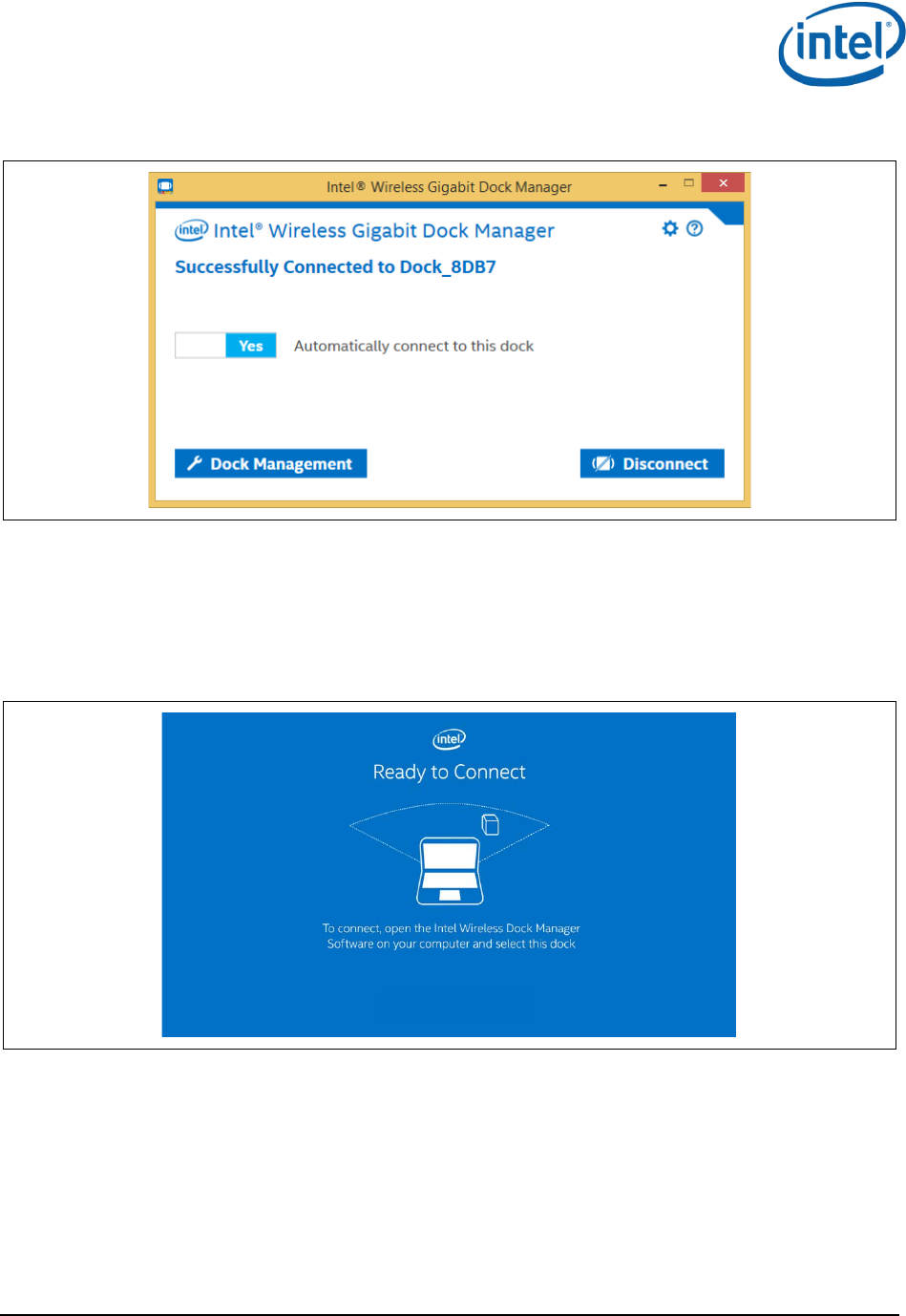
WiGig Application User Manual for Windows 7*/8*/8.1*
Intel® Wireless Gigabit v2.6
User Guide May 2016
20 Intel Confidential Document Number: 537178-3.9
Figure 3-11 Manual disconnect option
3. Another method for manually disconnecting is to press and hold the activity button on the dock for
more than four seconds. This method is especially useful for closed-lid operations, or if you are
trying to manually disconnect a system where you cannot access the Wireless Dock Manager (like
when the system is locked and you do not know the password).
Once disconnected, the dock LED changes color (color is specific to dock vendor), and the OSD
shows the Ready to Connect message, as shown in Figure 3-12.
Figure 3-12 Ready to connect message
Note: Manually disconnecting from a dock that is set to connect automatically will temporarily
disable auto-connect to this dock. This is to prevent the connection from being recovered
immediately. To re-enable automatic connections to this dock, the client needs to get out
of range (for about 13 seconds) and then return.
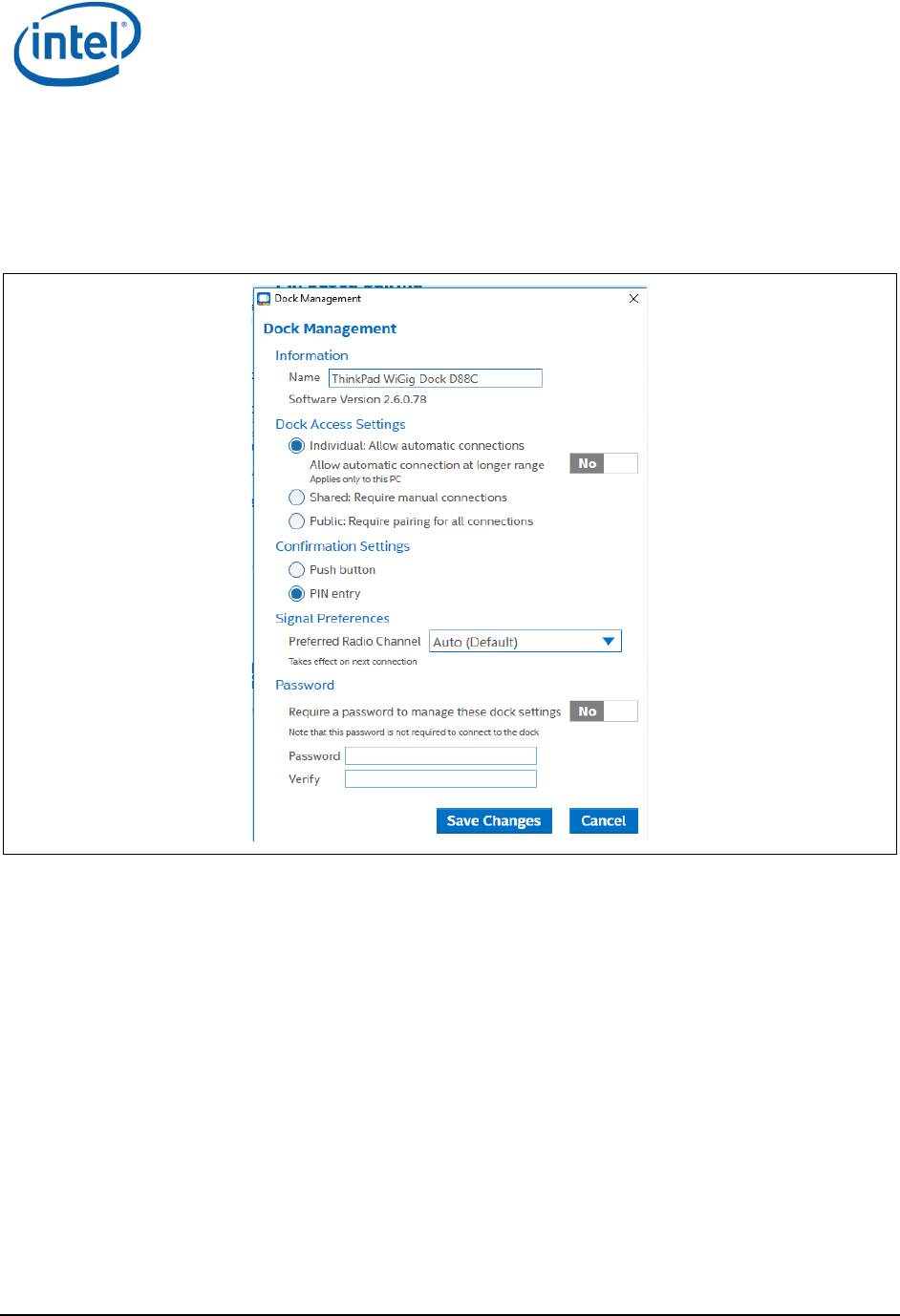
WiGig Application User Manual for Windows 7*/8*/8.1*
Intel® Wireless Gigabit v2.6
May 2016 User Guide
Document Number: 537178-3.9 Intel Confidential 21
3.1.9 PIN-based pairing
Intel Wireless Dock Manager version 2.6 or newer allows WiGig pairing using a PIN, without the need
to push the button on the dock. To enable PIN-based pairing, select the PIN entry option from the
Dock Management menu, as shown in Figure 3-13.
Figure 3-13 Enabling PIN-based pairing
There are dock products that have no push button option. Such docks are configured in the factory
with no PBC button available. (See Ref 7). For these dock products, PIN-based pairing is the default
pairing method, and the Confirmation Settings options do not appear in the Dock Management menu.
Once the PIN entry is configured, the user is prompted to enter the PIN number when trying to
connect to the dock, as shown in Figure 3-14. The PIN number will be shown in an OSD on the
monitor connected to the dock.
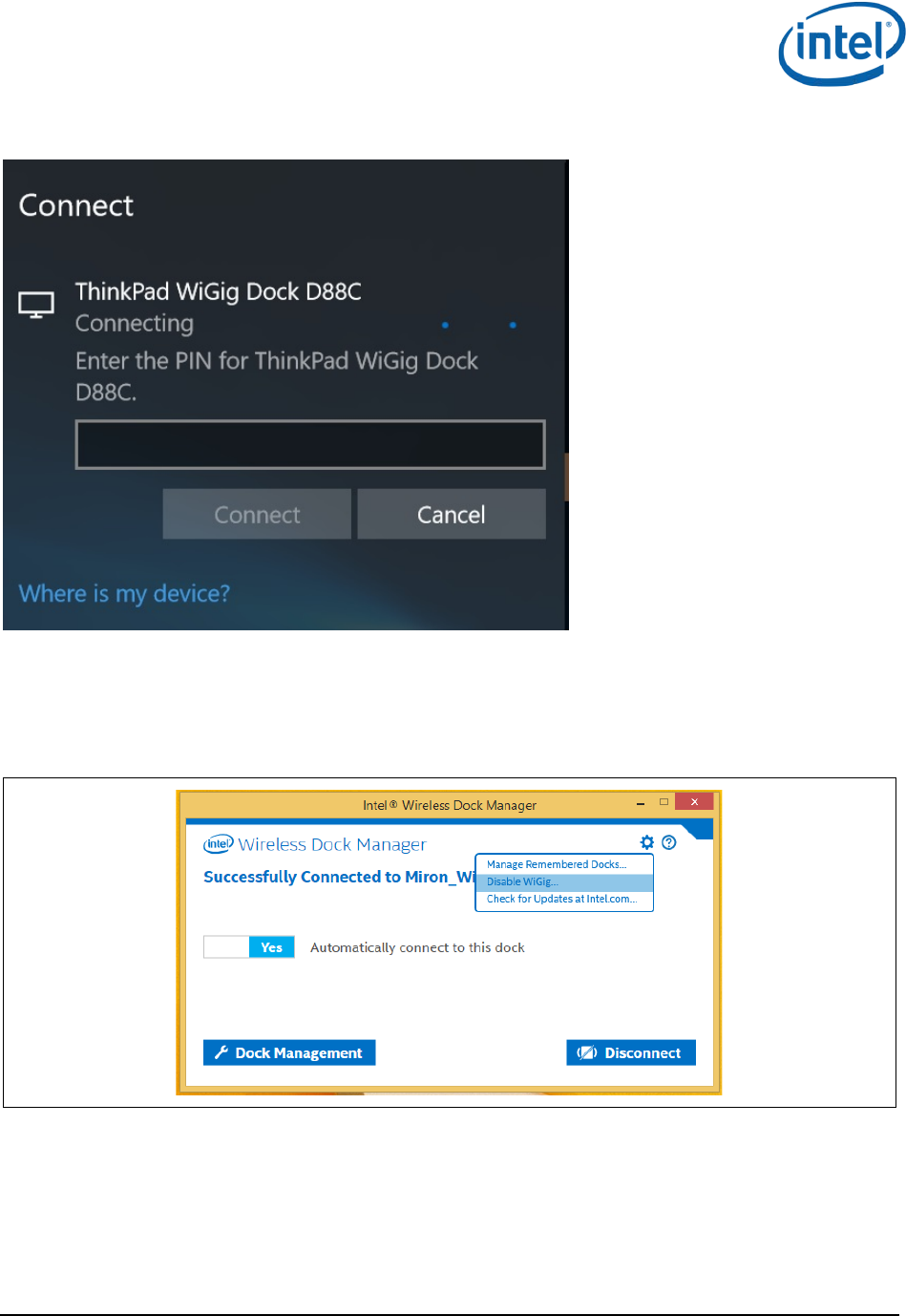
WiGig Application User Manual for Windows 7*/8*/8.1*
Intel® Wireless Gigabit v2.6
User Guide May 2016
22 Intel Confidential Document Number: 537178-3.9
Figure 3-14 PIN-based pairing in OSD
3.1.10 Disable and enable WiGig
1. To disable WiGig, click on the gear icon in the upper right of the main Wireless Dock Manager
screen, shown in Figure 3-14. A popup-menu will come up.
Figure 3-15 Disable WiGig using the gear icon
2. Choose the first menu option, Disable WiGig. A warning may appear, depending on whether you
are currently connected or not.
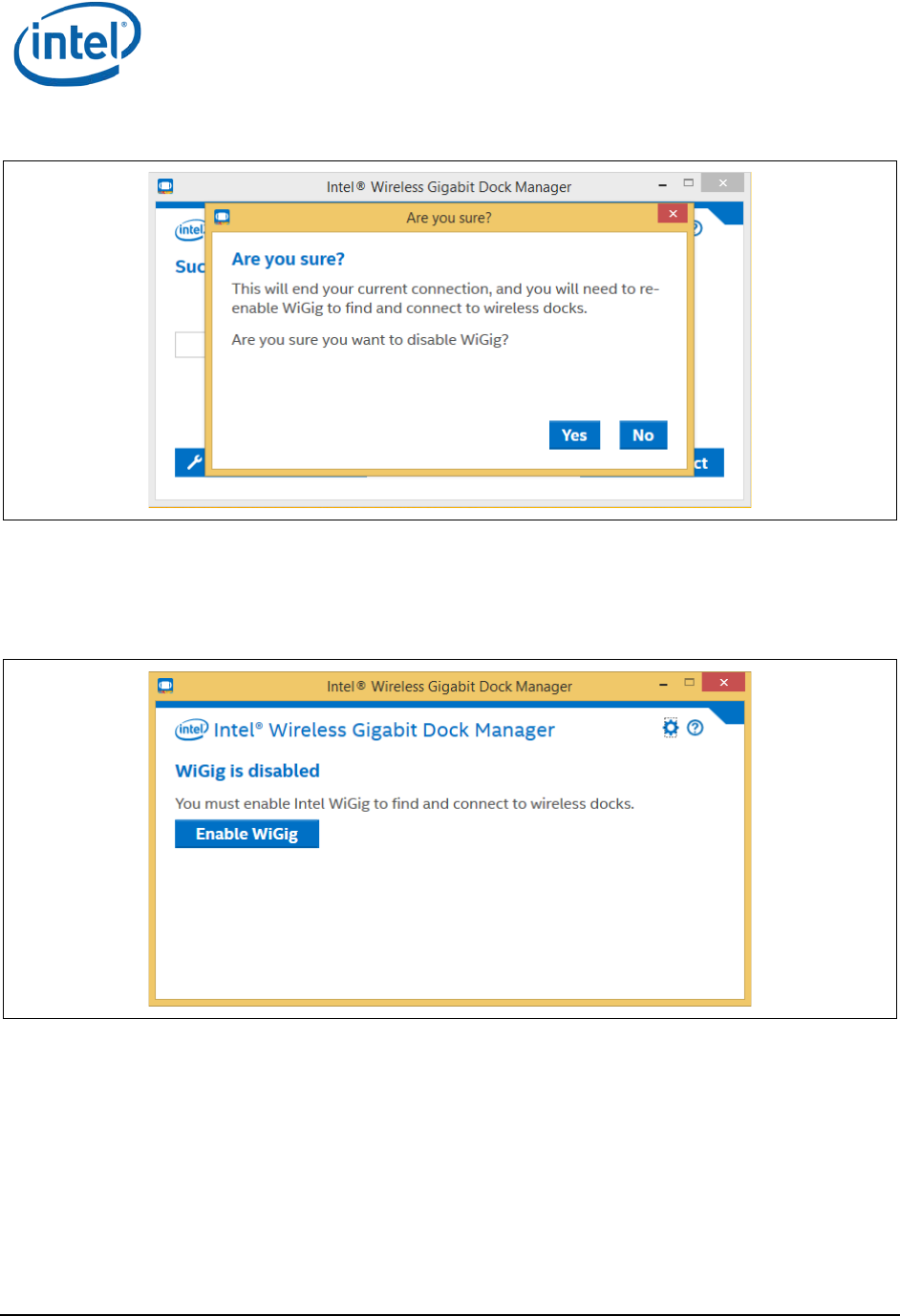
WiGig Application User Manual for Windows 7*/8*/8.1*
Intel® Wireless Gigabit v2.6
May 2016 User Guide
Document Number: 537178-3.9 Intel Confidential 23
Figure 3-16 Disable WiGig warning message
3. Choose Yes to disable WiGig.
4. When WiGig is disabled, you cannot find and connect to wireless docks; the message shown in
Figure 3-16 appears. Disabling WiGig minimizes the power consumption of the WiGig radio in the
client.
Figure 3-17 WiGig disabled confirmation message
5. To enable WiGig, click the Enable WiGig button.
3.2 Change dock settings
1. To access the dock settings, click the Dock Management button on the main Wireless Dock
Manager window while connected to a dock, as shown in Figure 3-17.
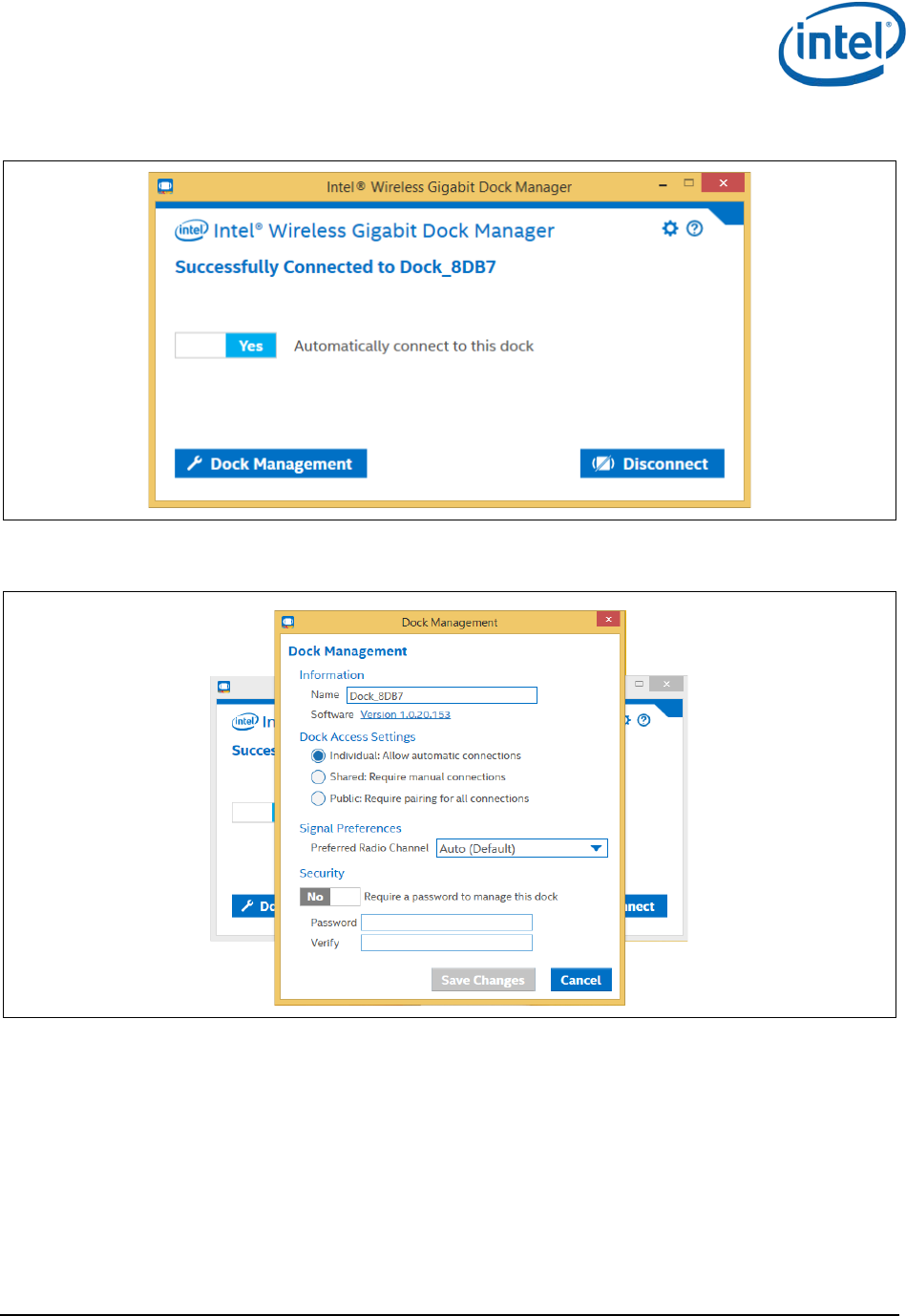
WiGig Application User Manual for Windows 7*/8*/8.1*
Intel® Wireless Gigabit v2.6
User Guide May 2016
24 Intel Confidential Document Number: 537178-3.9
Figure 3-18 Dock Management button
2. This will open up the Dock Management dialog box, as shown in Figure 3-18.
Figure 3-19 Dock management dialog box
3. In the Dock Management dialog box, you can configure the following settings:
– Information
Name: This field determines how will the dock be called and presented in the scan list in
the Wireless Dock Manager. This field accepts only Latin letters, digits, and a few special
characters such as space and underscore.
Note: The factory setting for dock name is a prefix, Doc, and an automatic suffix of the last four
nibbles of the MAC address of the dock. This helps users to distinguish between similar
docks whose names have not been customized. Once the user changes the dock name,
the last four nibbles of the MAC address are no longer appended to it. To re-enable this
behavior, the dock must be reset to the factory defaults by pressing the recovery button
on the dock for 10 seconds.

WiGig Application User Manual for Windows 7*/8*/8.1*
Intel® Wireless Gigabit v2.6
May 2016 User Guide
Document Number: 537178-3.9 Intel Confidential 25
Software: This shows the version of the currently installed software. Clicking this item will
allow you to manually update your dock software, as described in Section 3.3.1. Also,
when an update is available for your dock, it will show up next to the version number.
Click the Update Available link to start the software update procedure.
– Dock Access Settings
Individual: Allows automatic connections. This setting enables the auto-connect toggle on
connected clients, as described in Section 3.1.3. This is the only setting with which the
dock can be automatically connected to, and is particularly suitable for private docks for
individuals.
Shared: Requires manual confirmation. This setting forces manual connections by
disabling the auto-connect toggle on connected clients. This setting is particularly suitable
for shared docks in multi-users environments, where it may be undesirable to allow
automatic connection to prevent users from inadvertently connecting to the dock while in
range (remember that a dock that is currently connected to a user cannot accept other
user’s connections, and will not be seen in their scan list).
Public: Requires pairing for all connections. This settings forces the user to pair on every
connection (such as. pairing data is lost upon disconnect). This is the most secure setting,
and is mostly suitable for docks where the convenience of connection is less of a concern,
for example in airports, cafes or hotels.
– Signal Preferences
Preferred Radio Channel: Allows you to assign a specific operating channel, or enable
automatic selection by the dock. It is recommended to leave this as Auto, as this will allow
the dock to select the best channel to operate in, based on interference and other factors.
– Password
Enable this to assign a password for protecting the dock setting page, preventing
unauthorized access.
3.3 Dock software update
Your dock software can be upgraded over the air, from the client.
3.3.1 Update during connection
1. When connecting to the dock, the Wireless Dock Manager might inform the user of a mandatory
dock software update.
2. On mandatory dock software updates, the Wireless Dock Manager will present the message shown
in Figure 3-19 while trying to connect.
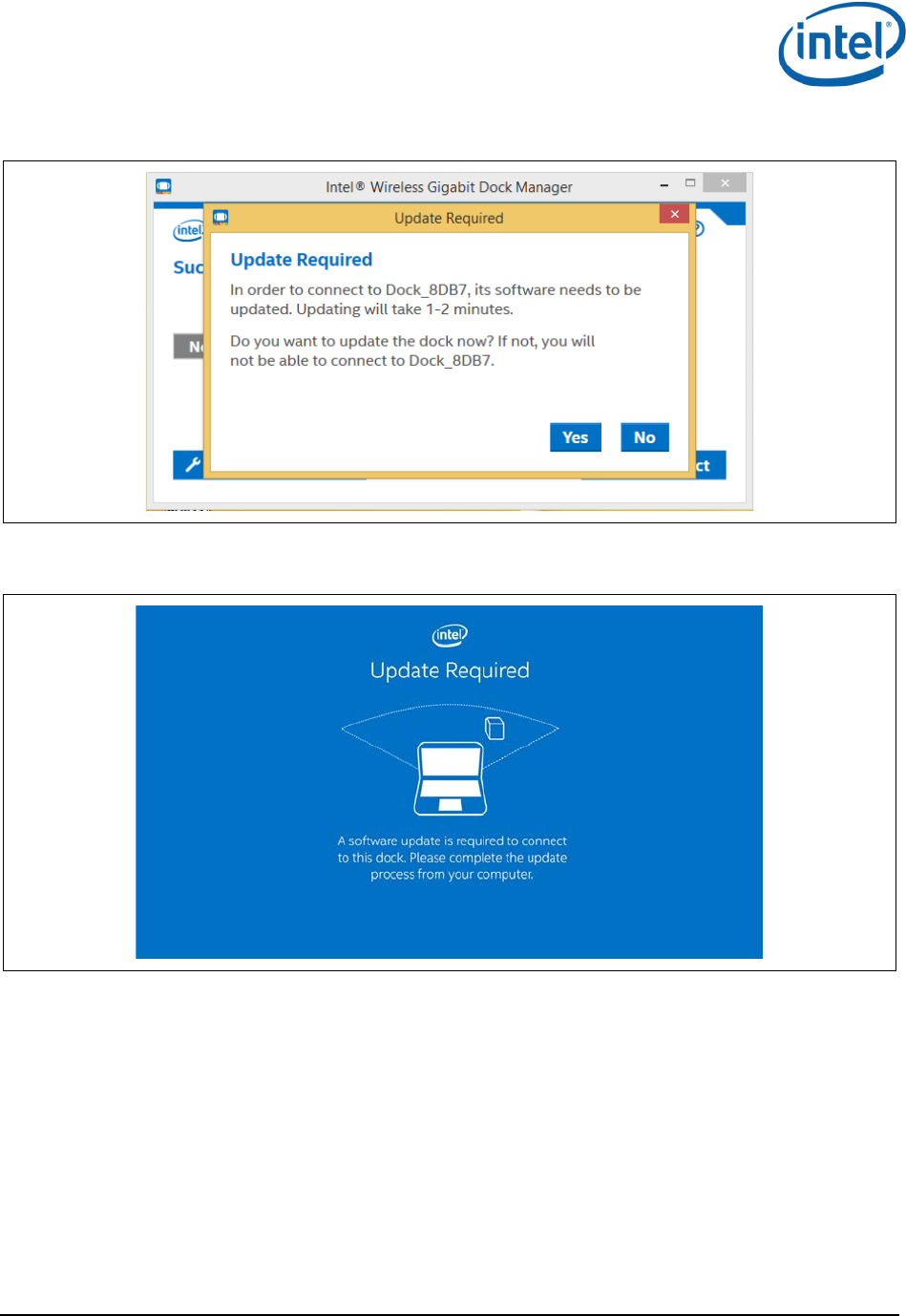
WiGig Application User Manual for Windows 7*/8*/8.1*
Intel® Wireless Gigabit v2.6
User Guide May 2016
26 Intel Confidential Document Number: 537178-3.9
Figure 3-20 Dock software Update Required message
3. In addition, the OSD on the external monitor will show the message shown in Figure 3-20.
Figure 3-21 OSD Update Required message
4. Choosing No will disconnect. The user cannot connect and work with this dock without performing
a software update.
5. Choosing Yes will start the dock software update process. A screen similar to the one in Figure
3-21 appears, with a bar indicating progress.
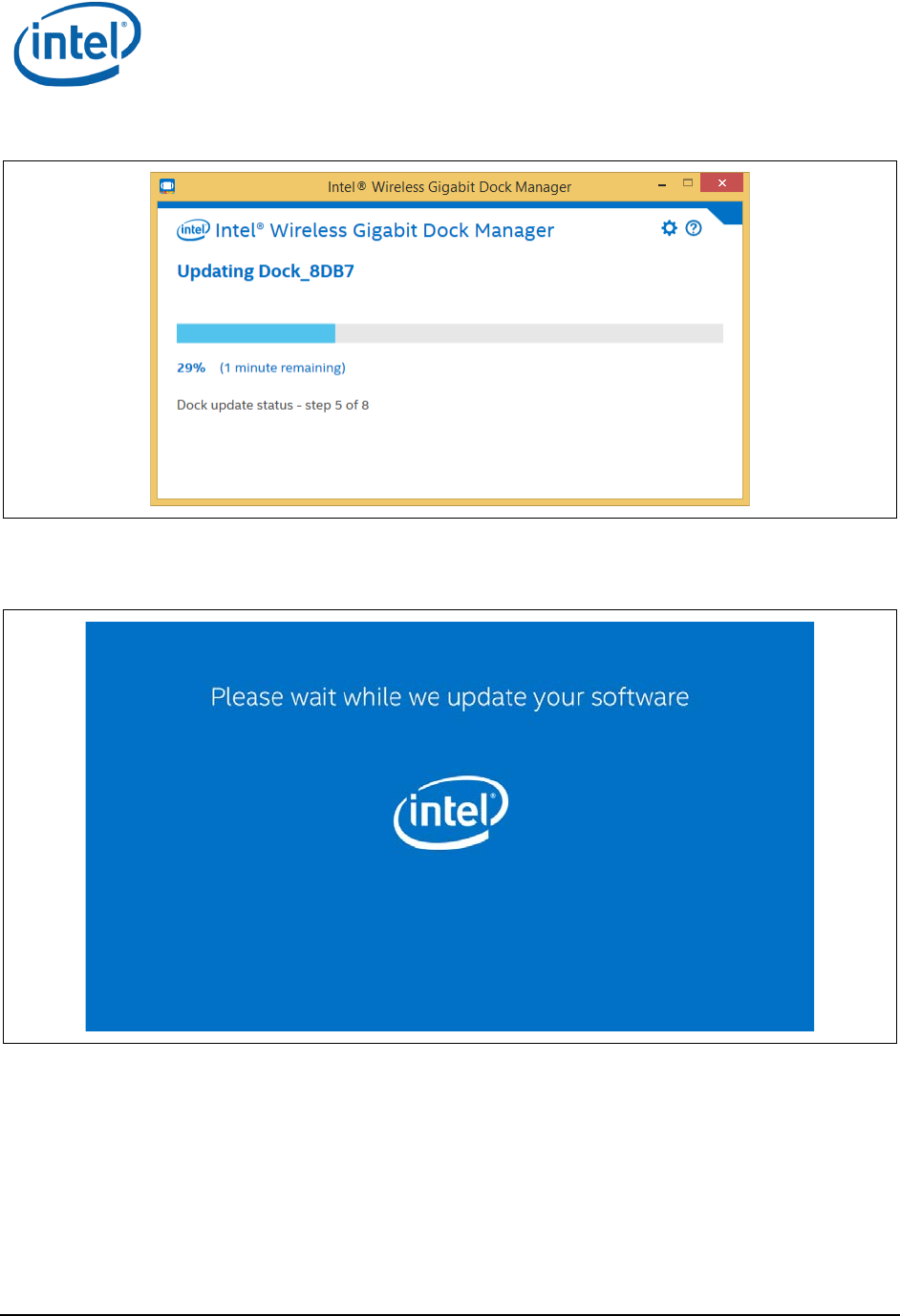
WiGig Application User Manual for Windows 7*/8*/8.1*
Intel® Wireless Gigabit v2.6
May 2016 User Guide
Document Number: 537178-3.9 Intel Confidential 27
Figure 3-22 Dock update progress
6. During the software update process, the dock LED changes color (color is specific to dock vendor),
and the OSD will show the message pictured in Figure 3-22, with bars to indicate progress.
Figure 3-23 OSD update progress message
7. Once the update process is complete, the dock is reset, and the client will either automatically re-
connect (auto-connect enabled) or the user will need to manually re-connect to the dock (auto-
connect disabled).
3.4 Diagnostic information
Information shown in diagnostics window will help technical support in troubleshooting your wireless
docking experience. In order to open the diagnostics window, click the Advanced Diagnostics button in
the About window.
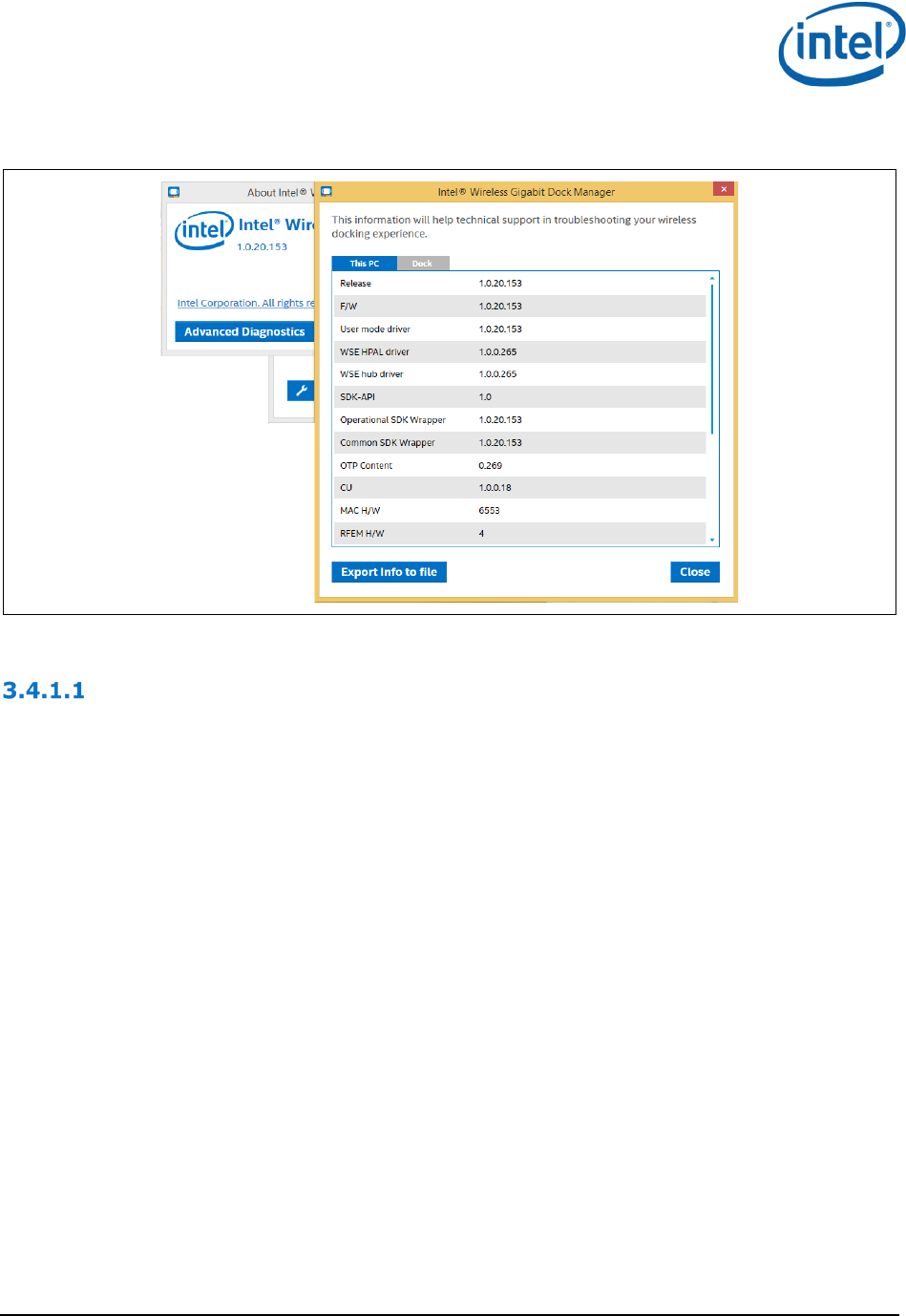
WiGig Application User Manual for Windows 7*/8*/8.1*
Intel® Wireless Gigabit v2.6
User Guide May 2016
28 Intel Confidential Document Number: 537178-3.9
Figure 3-24 Advanced diagnostics window
3.4.1 Details
This PC tab
The information in the This PC tab provides a diagnostic report for the client.
The reported fields are:
Release: Version of WiGig release, including all SW components in host and device
F/W: Version of firmware running in device
User mode driver: Version of software running in user-mode driver
WSE HPAL driver: Version of software running in WSE-HPAL driver
WSE hub driver: Version of software running in WSE-hub driver
SDK-API: Version of SDK-API
Operational SDK Wrapper: Version of Operational SDK DLL
Common SDK Wrapper: Version of Common SDK DLL
OTP Content: Version of image burned in OTP
CU: Version of CU Application
MAC H/W: Version of M-Chip Si. Possible values are:
– 6560-6567: For MpL-C4
– 6568-6575: For MpL-C5
R-FEM H/W: Version of R-Chip. Possible values are:
– 4-5: in case of R-FEM1
– 6: in case of R-FEM2
Device ID: 0x93C, meaning MpL Si
Subsystem ID: Value representing WiGig HW SKU. Details are given in Ref 4.
OEM ID: String configured in OEM-Lock field in BIOS. See more details in Section 8.1.2 in Ref 6.
Device State: See details for Device status field in Section 5.2.1.1.1 in Ref 5.

WiGig Application User Manual for Windows 7*/8*/8.1*
Intel® Wireless Gigabit v2.6
May 2016 User Guide
Document Number: 537178-3.9 Intel Confidential 29
Device State Reason: See details for Reason for Status field in Section 5.2.1.1.1 in Ref 5.
Last Disconnect Reason: See details for Failed Connection Details field in Section 5.4.11 in Ref
5.
H/W status 1: M-chip junction temperature, in Celsius.
H/W status 2: R-chip junction temperature, in Celsius.
Dock Tab
The information in the This PC tab provides a diagnostic report for the dock.
The reported fields are
F/W (main): Version of firmware burned in main slot in Flash
F/W (factory): Version of firmware burned in factory slot in Flash
Active F/W: See details for Active FW field in Section 5.7.20 in Ref 5.
OTP Content: Version of image burned in OTP
MAC H/W: Version of M-Chip Si. Possible values are
– 6560-6567: For MpL-C4
– 6568-6575: For MpL-C5
R-FEM1 H/W: Version of R-Chip. Possible values are
– 4-5: In case of R-FEM1
– 6: In case of R-FEM2
R-FEM2 H/W: Version of R-Chip. Possible values are the same as for R-FEM1.
MST Hub H/W: Version of MST Hub hardware
MST Hub F/W: Version of MST Hub firmware
Signal Quality: See details for the Peer-Signal-Quality field in Section 5.4.8 in Ref 5.
Performance Quality: See details for the Peer-Performance-Quality field in Section 5.4.8 in Ref
5.
Active Channel: See details for the Active Channel field in section 5.4.8 in Ref 5.
Last F/W update result: See details for the Status field in Section 5.2.1.6 in Ref 5.
H/W status 1: M-chip junction temperature, in Celsius
H/W status 2: R-chip junction temperature, in Celsius
3.5 Manage docks
The user may manage docks that were previously connected to. For each dock, the user may delete
the dock or remove the auto-connect option. To manage docks, click on the Manage Remembered
Dock dialog box from the Settings button, as shown in Figure 3-24 and Figure 3-25.
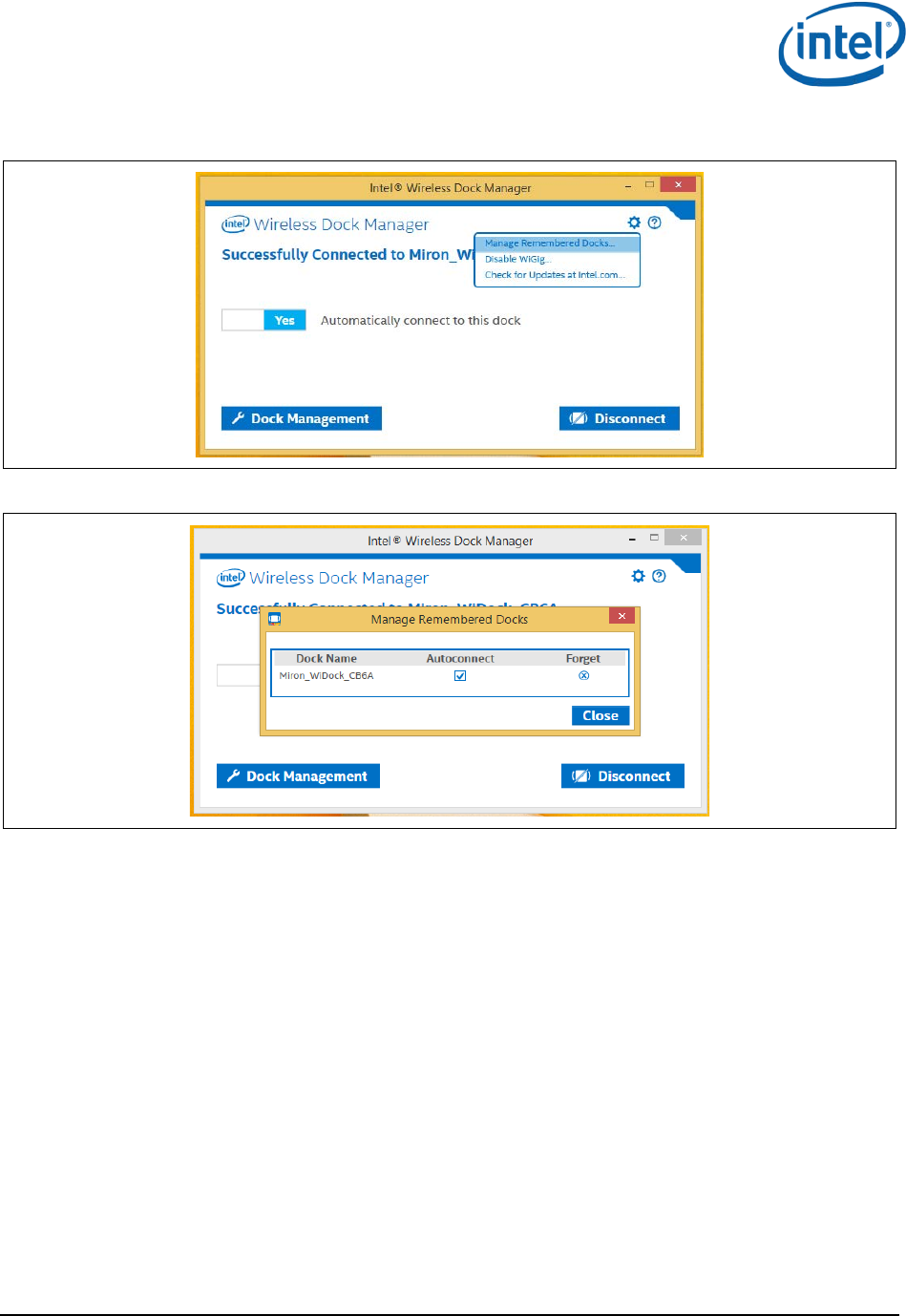
WiGig Application User Manual for Windows 7*/8*/8.1*
Intel® Wireless Gigabit v2.6
User Guide May 2016
30 Intel Confidential Document Number: 537178-3.9
Figure 3-25 Choosing Manage Remembered Docks
Figure 3-26 Manage Remembered Docks auto-connect feature
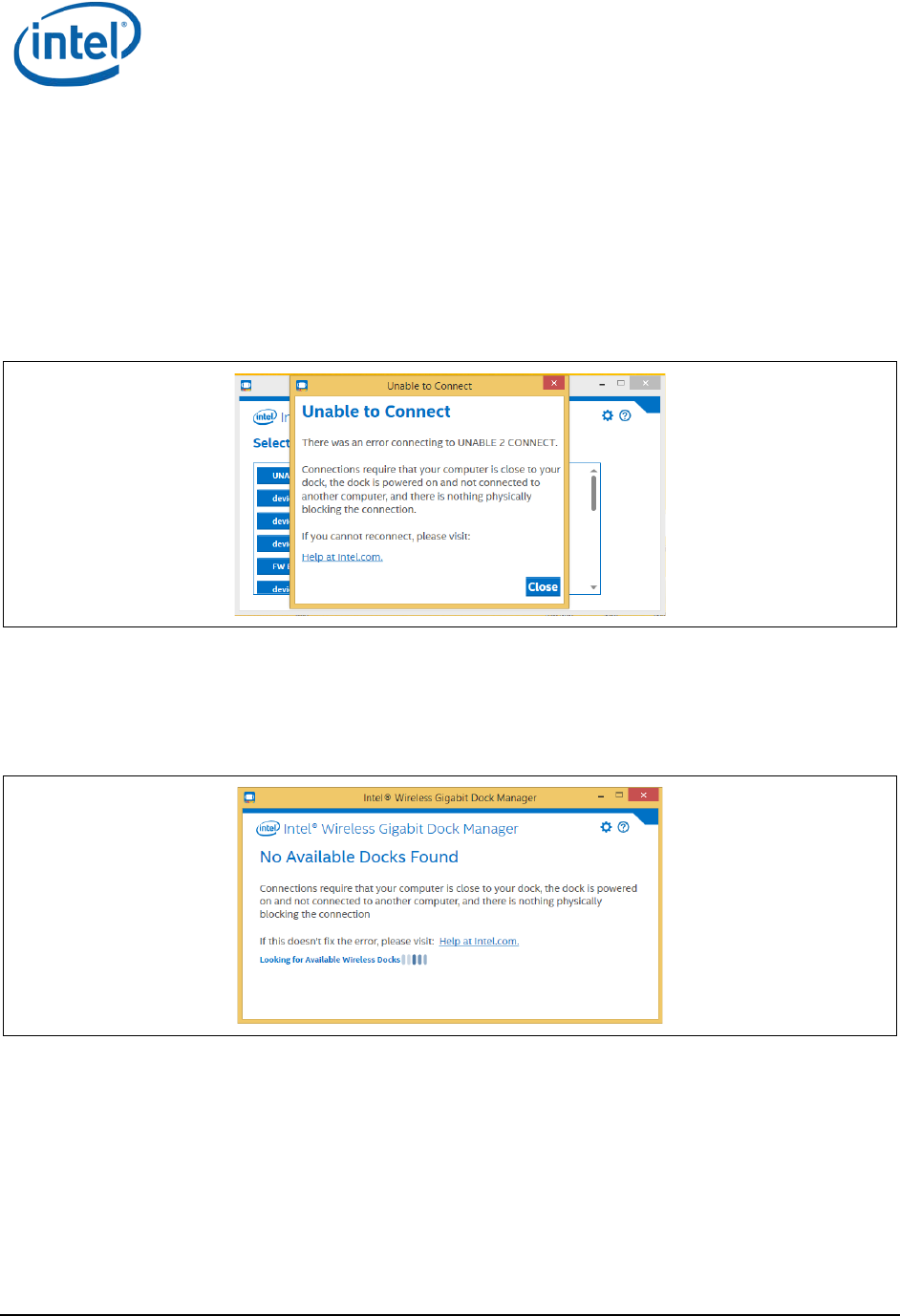
WiGig Application User Manual for Windows 7*/8*/8.1*
Intel® Wireless Gigabit v2.6
May 2016 User Guide
Document Number: 537178-3.9 Intel Confidential 31
3.6 Notification messages
There are notification messages that inform the user about the different application activities, like
possible limitations or errors.
3.6.1 Unable to Connect
The “Unable to Connect” message is displayed if there is an error during the connection or pairing
process, as shown in Figure 3-26.
Figure 3-27 Unable to Connect message
3.6.2 No Available Docks Found
As shown in Figure 3-27, the “No Available Docks Found” message is displayed if scanning was done
but no docks have been detected.
Figure 3-28 No Available Docks Found message
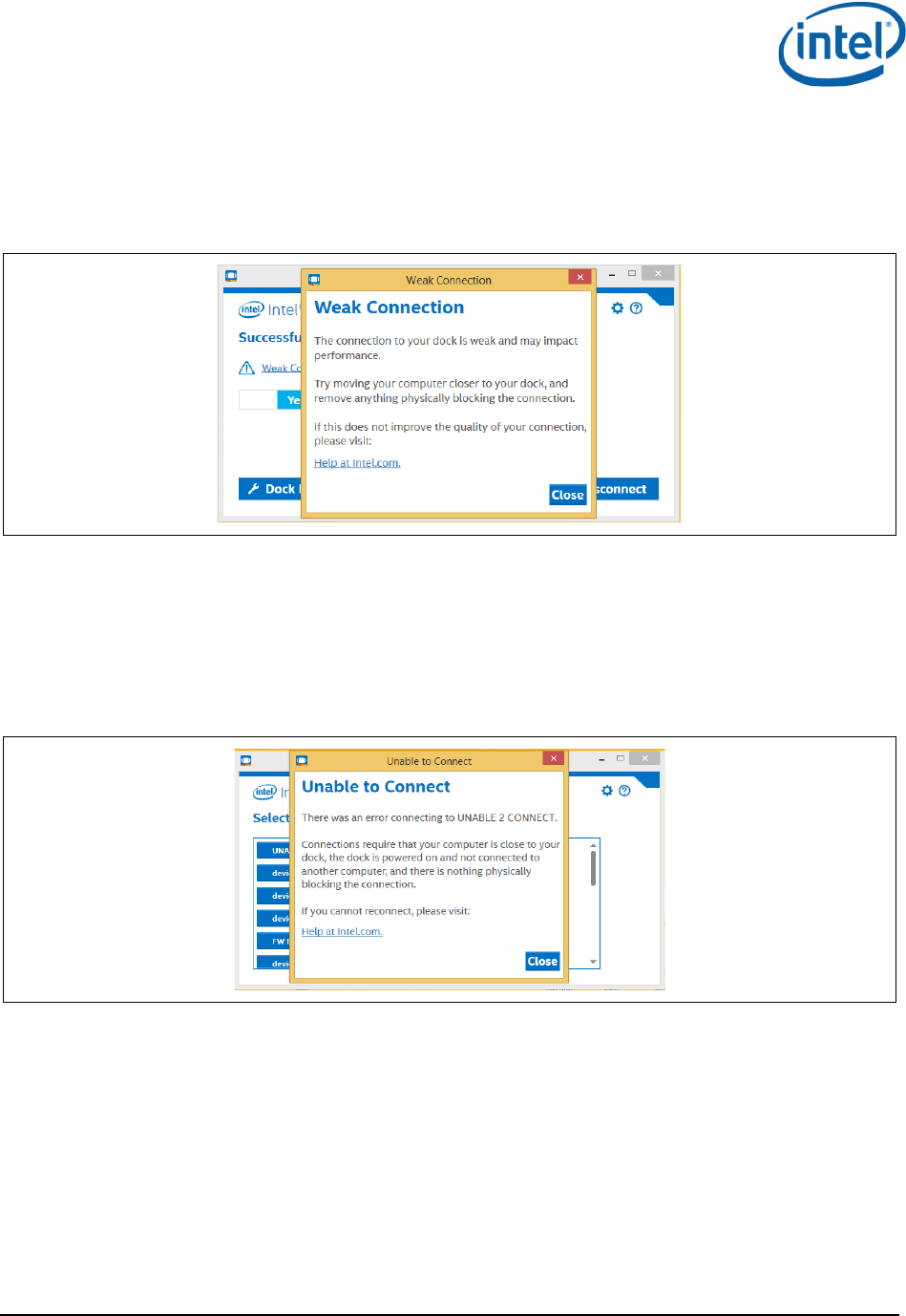
WiGig Application User Manual for Windows 7*/8*/8.1*
Intel® Wireless Gigabit v2.6
User Guide May 2016
32 Intel Confidential Document Number: 537178-3.9
3.6.3 Weak Connection
The “Weak Connection” message is displayed if the connection is weak but connected, as shown in
Figure 3-28.
Figure 3-29 Weak Connection message
3.6.4 WiGig is Not Working
The “WiGig is Not Working” message will be displayed if WiGig driver or device is not responding, as
shown in Figure 3-29. The message will also provide an error code value. Table 3–1 provides a list of
error code cases and possible recovery methods.
Figure 3-30 WiGig is Not Working message (with example error code 0x1000)

WiGig Application User Manual for Windows 7*/8*/8.1*
Intel® Wireless Gigabit v2.6
May 2016 User Guide
Document Number: 537178-3.9 Intel Confidential 33
Table 3–1 Error code cases and possible recovery methods
Item Error
Code Description Recovery Method
1 0x1000 Device is disabled In Device Manager,
• If WiGig device is disabled,
enable this device.
• If WiGig device is enabled,
disable this device and then
enable.
2 0x100C Device Version (OTP) is incompatible with
SW Version. Replace Device with compatible Device
Version (OTP) or Install compatible SW
Version
3 0x1010 FW continuous error In Device Manager, disable this device
and then enable.
In case this does not solve the problem,
you may need to install other SW
Version, containing a fix. Please contact
Intel support.
4 0x1014 RTC Data corruption Replace Coax Cable and/or RFEM
5 0x1018 RFEM Type is incompatible with SW
Version Replace RFEM with compatible RFEM
Type or Install compatible SW Version
6 0x101C Device SKU is Incompatible with SW
Version. Replace Device SKU or Install
compatible SW Version
7 0x1021 Device Product is Incompatible with SW
Version. Replace Device with compatible Device
Product or Install compatible SW
Version
8 0x1020 RTC disconnected, upon RF-On Replace/Reconnect Coax Cable and/or
RFEM
9 0x1100 Unrecognized fatal error In Device Manager, disable this device
and then enable.
In case this does not solve the problem,
you may need to install another SW
version, containing a fix. Please contact
Intel support.
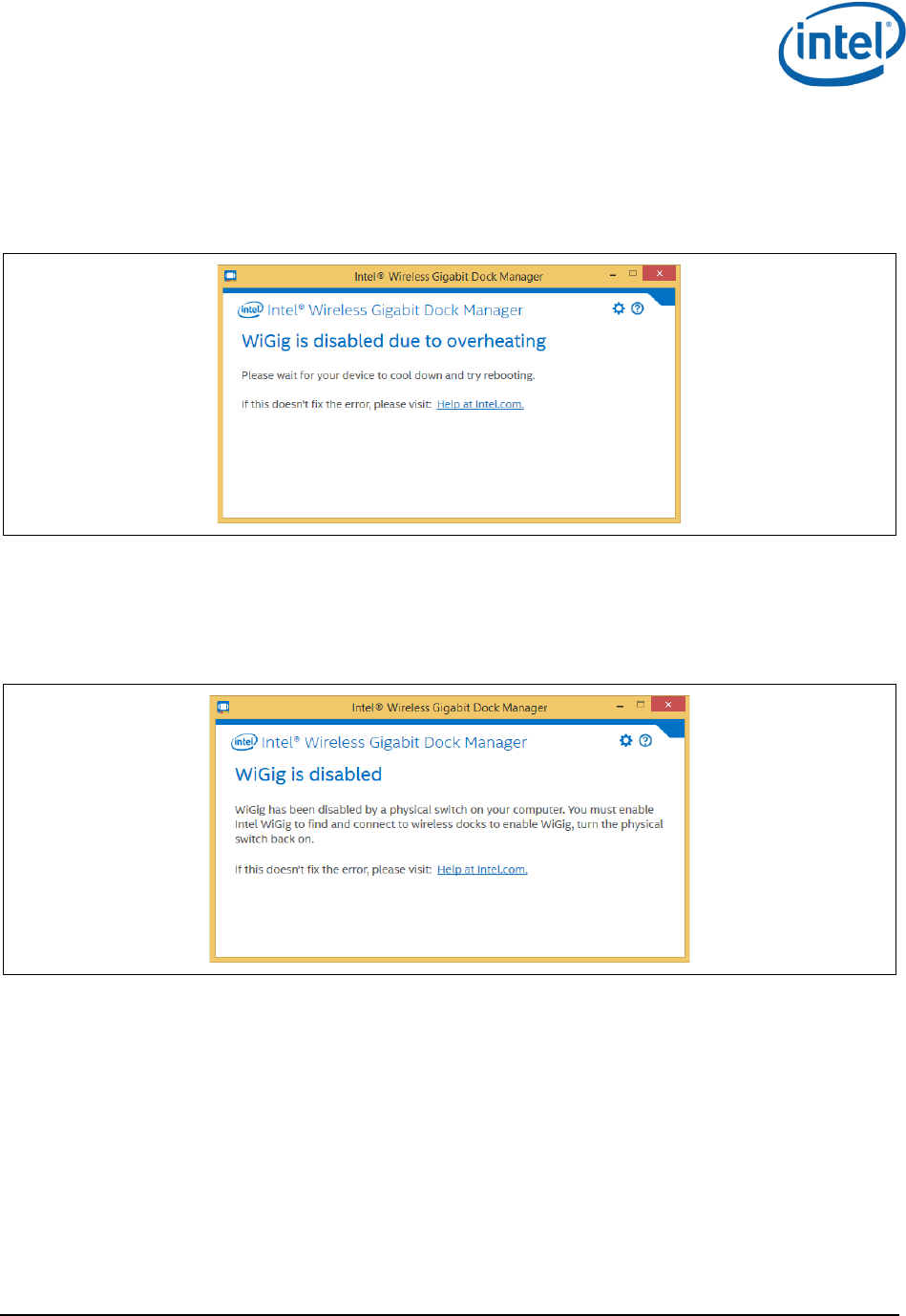
WiGig Application User Manual for Windows 7*/8*/8.1*
Intel® Wireless Gigabit v2.6
User Guide May 2016
34 Intel Confidential Document Number: 537178-3.9
3.6.5 WiGig disabled: critical temperature
The “WiGig is disabled due to overheating” message is displayed if the WiGig driver or device is
disabled due to a critical temperature error, as shown in Figure 3-30.
Figure 3-31 WiGig disabled due to overheating message
3.6.6 WiGig disabled by hardware RF kill switch
The “WiGig is disabled” message is displayed if the WiGig driver or device is disabled by the physical
radio on/off switch, as shown in Figure 3-31.
Figure 3-32 WiGig disabled by hardware RF kill switch message

WiGig Application User Manual for Windows 7*/8*/8.1*
Intel® Wireless Gigabit v2.6
May 2016 User Guide
Document Number: 537178-3.9 Intel Confidential 35
3.6.7 WiGig disabled by airplane mode
The “WiGig is disabled” message is displayed if the WiGig driver or device is disabled because the
device is in airplane mode, as shown in Figure 3-32.
Figure 3-33 WiGig disabled by airplane mode message
§

WiGig Application User Manual for Windows 10*
Intel® Wireless Gigabit v2.6
User Guide May 2016
36 Intel Confidential Document Number: 537178-3.9
4 WiGig Application User Manual for
Windows 10*
4.1 User manual
This chapter is very similar to the previous chapter and contains the WiGig behavior in the
Windows 10* OS.
In Windows 10*, the OS controls the network-related functionality. This includes handling the radio
state, scanning, connecting, and managing the profiles. The OS controls this via the setting and the
action center pane, as described below.
The Intel® Wireless Dock Manager is a dedicated application that runs on the client and allows the
user to do all the activities that are not related to network management, like manage the dock, get
diagnostic info, do FWU, etc.
LEDs on the dock, and an on-screen display (OSD) on the monitor connected to the dock, provide
further feedback about the dock status, and assist the user in performing actions.
The activity button on the dock is used in some of the flows (like pairing and
connecting/disconnecting).
4.1.1 Launch the Intel® Wireless Dock Manager
The Intel® Wireless Dock Manager starts automatically with Windows.
To invoke the Intel® Wireless Dock Manager interface, double-click the icon on the desktop,
labeled “Intel® Wireless Dock Manager”.
Alternatively, double-click the WiGig tray icon while the device is connected to a dock (the
connected icon as shown in Figure 3-1 ).
The Intel® Wireless Dock Manager application keeps running as an application even if you click the X
(close window) icon on the application. To stop it, you must use the Windows Task Manager.
4.1.2 Make the first connection
1. Turn on the power to your dock. When the dock is ready to accept connections, the external
monitor lights up and shows the Welcome OSD message, as shown in Figure 4-1.
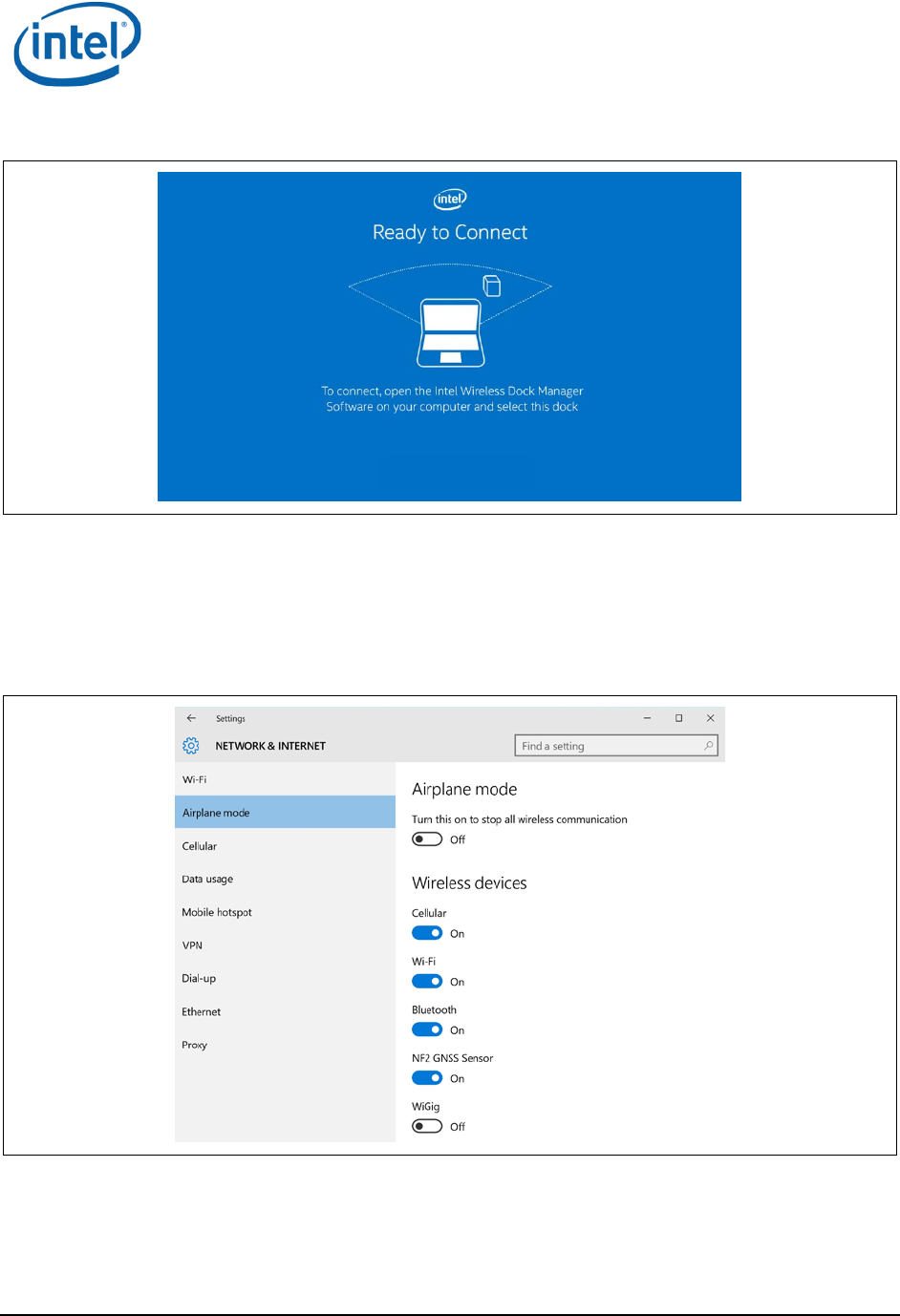
WiGig Application User Manual for Windows 10*
Intel® Wireless Gigabit v2.6
May 2016 User Guide
Document Number: 537178-3.9 Intel Confidential 37
Figure 4-1 Welcome OSD message
2. This message persists until the connection is made. After a few minutes of inactivity, the monitor
turns off to conserve power. Press the dock’s Activity button to wake up the monitor and continue
with the connection.
3. Click the Wireless Settings link to access the Airplane mode section of the Network & Internet
page (Figure 4-2) containing controls that let you turn on (or off) the WiGig RF mode in addition to
the RF state of other devices. WiGig will be ON by default.
Figure 4-2 Network & Internet page showing Airplane mode settings
4. An alternative way to get to this page is via Settings -> Network & Internet -> Airplane mode.
5. Once you set the WiGig radio button to on, you will find all docks in range. In Windows 10*, you
won’t be able to see the scan results in the Connect pane or in the Intel® Wireless Dock Manager.
6. To get to the Connect pane, click on the Action Center link (Figure 4-3) or press the keyboard
shortcut Win+k; the Connect pane opens on the right side of the monitor (Figure 4-4).
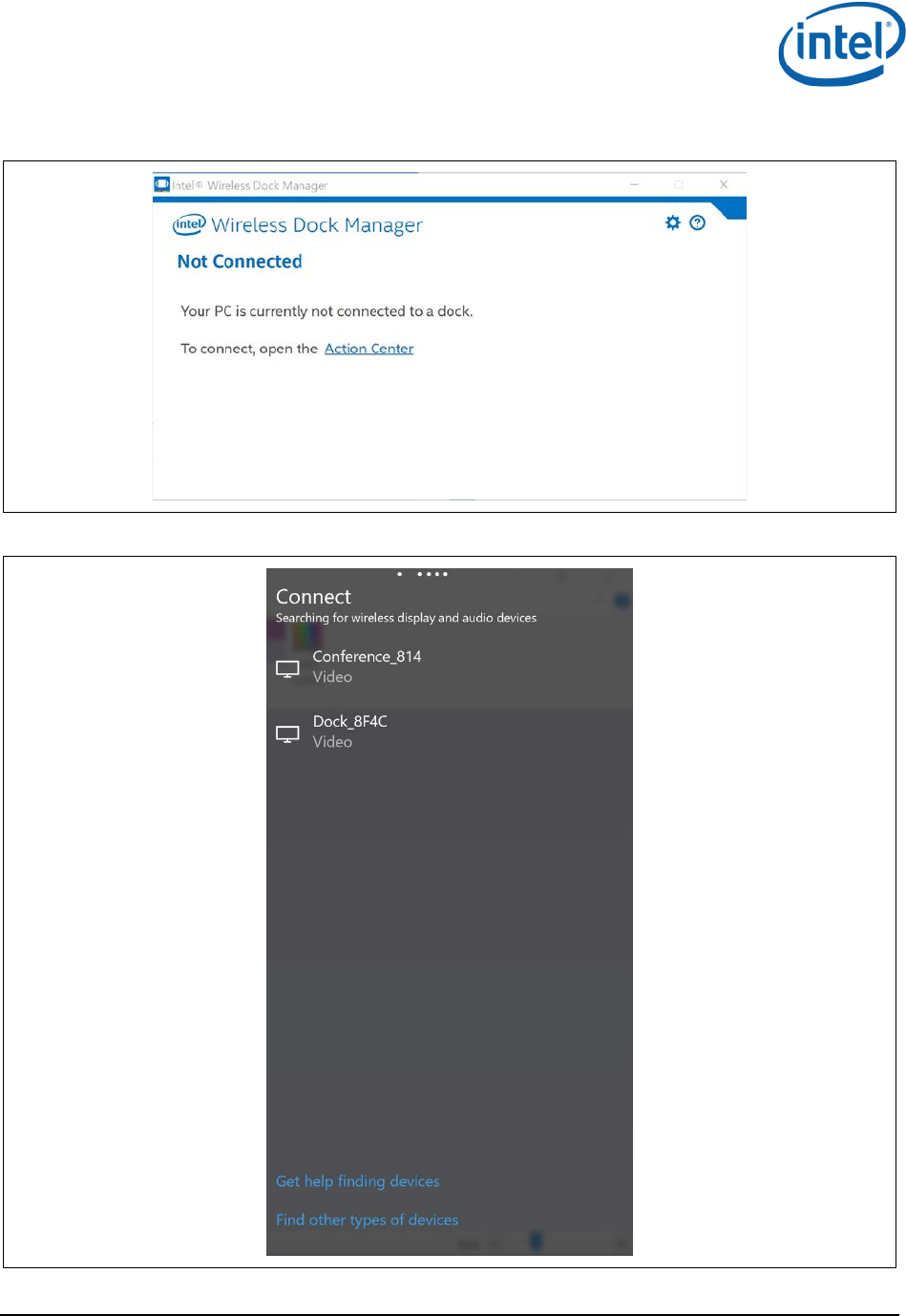
WiGig Application User Manual for Windows 10*
Intel® Wireless Gigabit v2.6
User Guide May 2016
38 Intel Confidential Document Number: 537178-3.9
Figure 4-3 Action Center link
Figure 4-4 Connect pane
7. Choose the dock you wish to connect to by clicking it in the Connect pane.
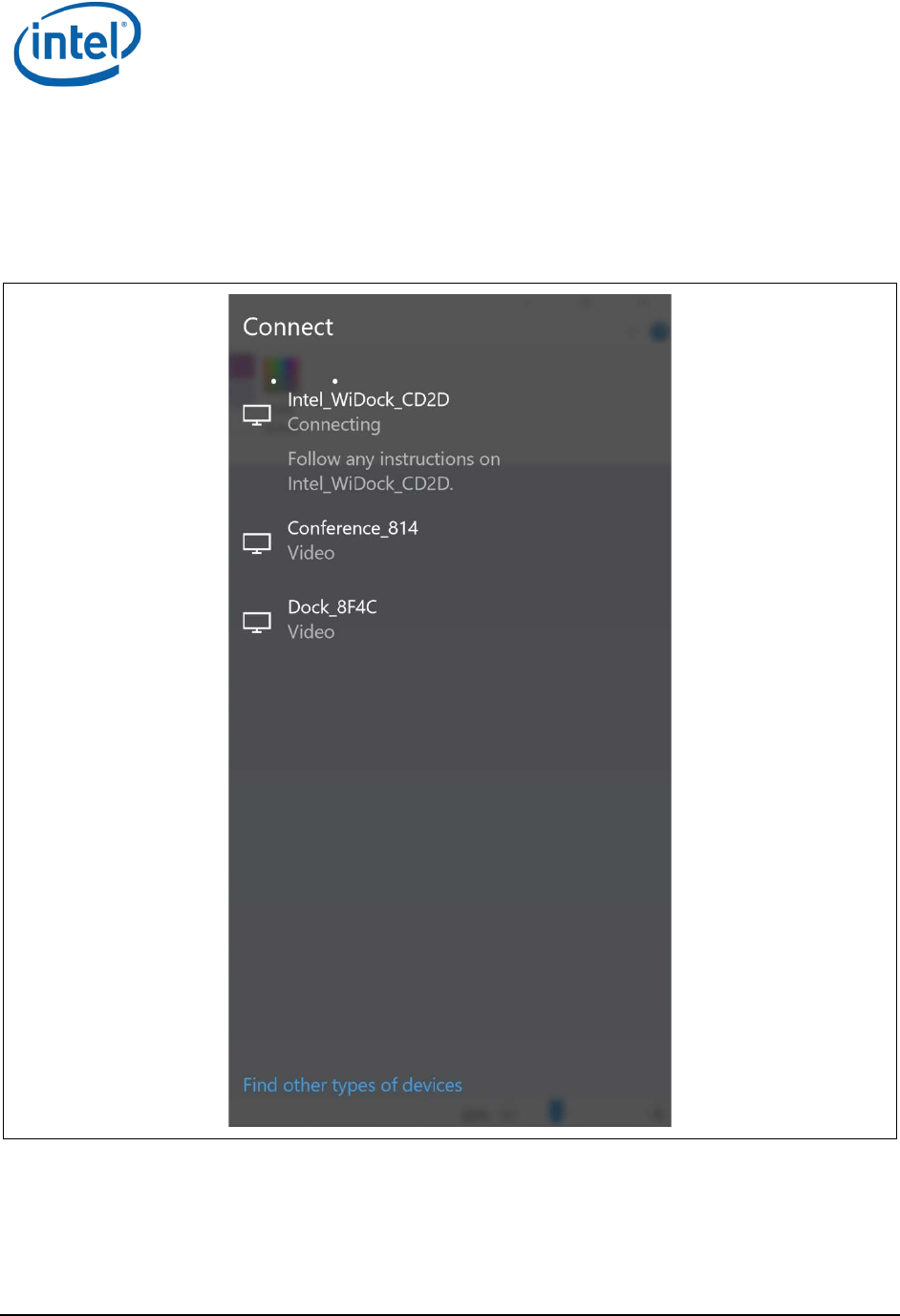
WiGig Application User Manual for Windows 10*
Intel® Wireless Gigabit v2.6
May 2016 User Guide
Document Number: 537178-3.9 Intel Confidential 39
Note: Since this is the first time connecting to the dock, you need to pair with it. Pairing creates
a set of authentication keys that uniquely identify your client and dock pair, and allows
them to communicate in a secured, encrypted manner over the air.
8. After connecting, the Connect pane directs you to follow the instructions on the dock, as shown in
Figure 4-5.
Figure 4-5 Connect pane during connecting stage
9. A corresponding OSD will appear on the external monitor, as shown in Figure 4-6.
10. Unlike in Win7/8/8.1, you won’t see the indication to push the dock button on Intel® Wireless
Dock Manager.
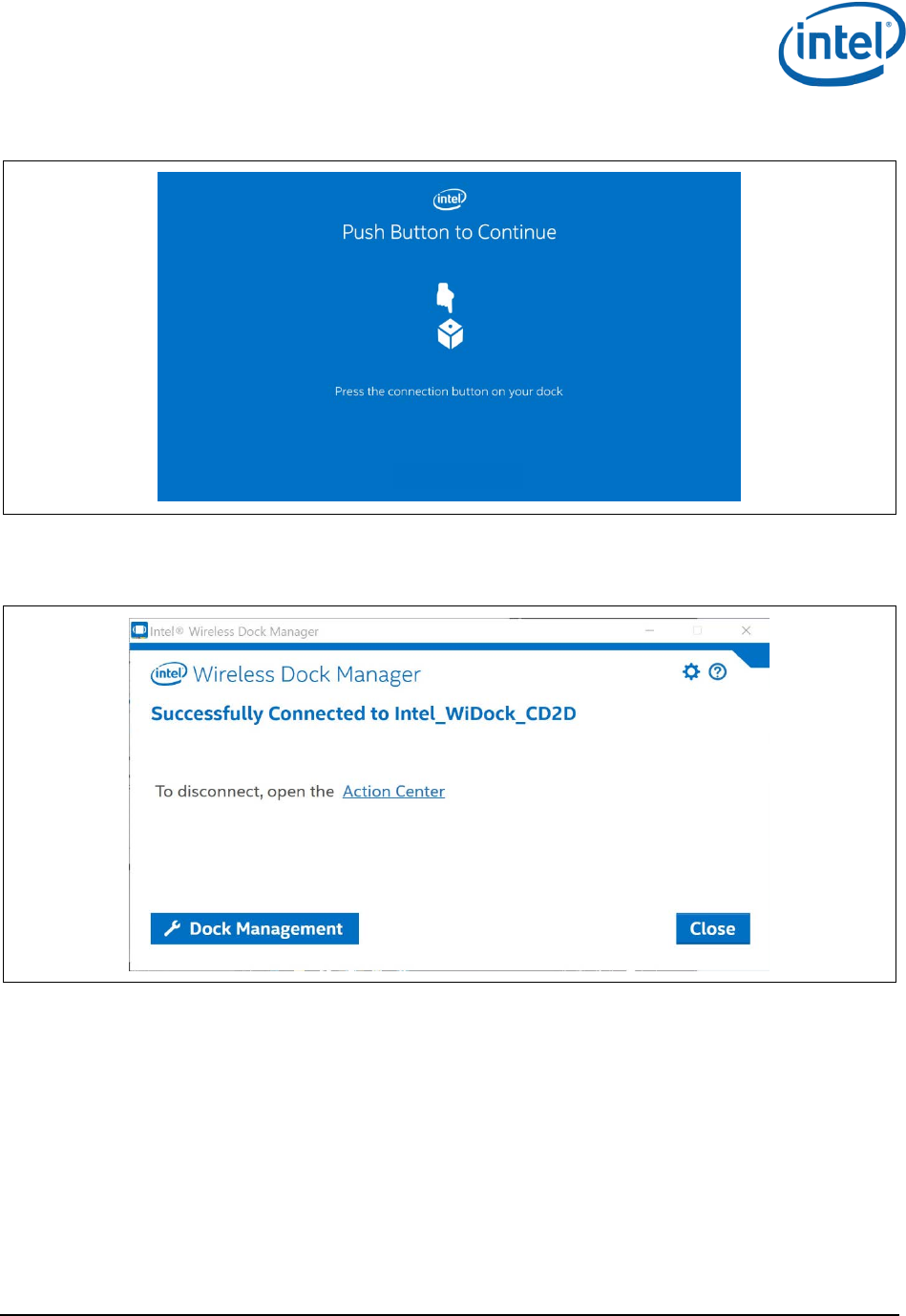
WiGig Application User Manual for Windows 10*
Intel® Wireless Gigabit v2.6
User Guide May 2016
40 Intel Confidential Document Number: 537178-3.9
Figure 4-6 Connect OSD message
11. Press the activity button on the dock to complete the pairing process. The “Successfully
Connected” message appears shortly after, as shown in Figure 4-7.
Figure 4-7 Dock connected message
Note: A successful connection is indicated by the dock LED (if available), and the external
monitor and USB devices being connected and enumerated on your client (you will hear
the Window’s gling-gling hot-plug audio cues).
In addition you are also able to see that you are connected via the Connect pane by clicking the Action
Center link, or by pressing the keyboard shortcut Win+K, as shown in Figure 4-8.
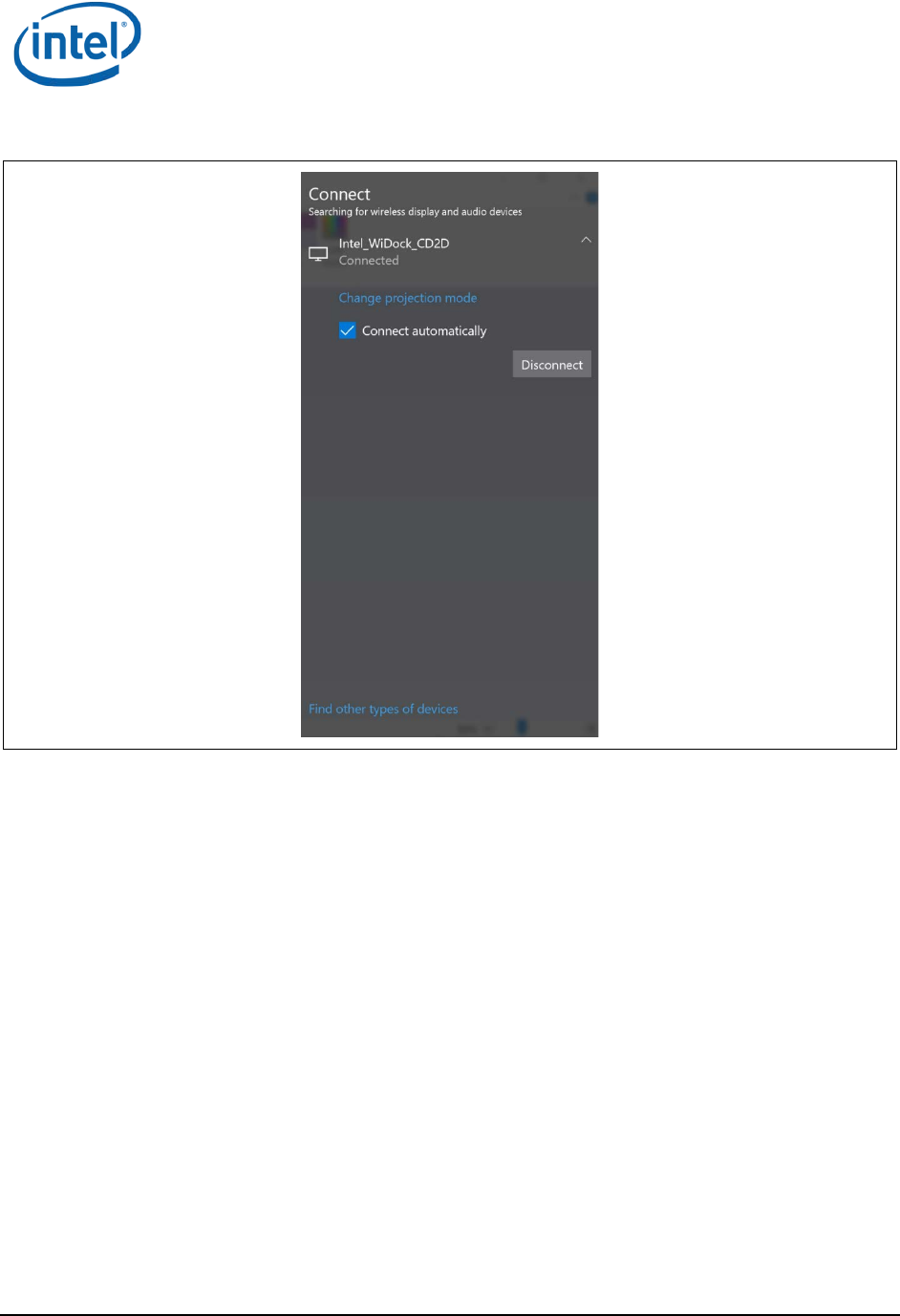
WiGig Application User Manual for Windows 10*
Intel® Wireless Gigabit v2.6
May 2016 User Guide
Document Number: 537178-3.9 Intel Confidential 41
Figure 4-8 Dock connected OSD message
Congratulations! You have made your first wireless docking connection.
4.1.3 Automatic connection default
This section is not applicable to Win10* as in Win7*/8*/8.1*. In Windows 10*, the dock is in
automatically connect mode.
4.1.4 Automatic connections
If a dock is set to connect automatically, WiGig attempts to automatically connect to the dock once in
range. To this end, WiGig keeps scanning in the background, while consuming very little power.
To connect, simply place your client (assumed to be in S0) near the dock. Within several seconds,
WiGig will discover the dock and connect to it automatically. You do not have to invoke the Wireless
Dock Manager, open the lid or take any action; just wait until the external screen comes up and USB
devices are enumerated, and you can start working.
When successfully connected to a dock, the dock LED changes color (specific to the dock vendor).
Note: For the connection to be fully completed automatically, as described above, the client
needs to be powered on and active (such as in S0). If the client is in S3, WiGig will
automatically discover the dock, and then you can use the dock button to wake up the
client and complete the docking procedure. See Section 3.1.6 for more details. Ability to
wake up the client from the dock is vendor specific and is configured in the BIOS.
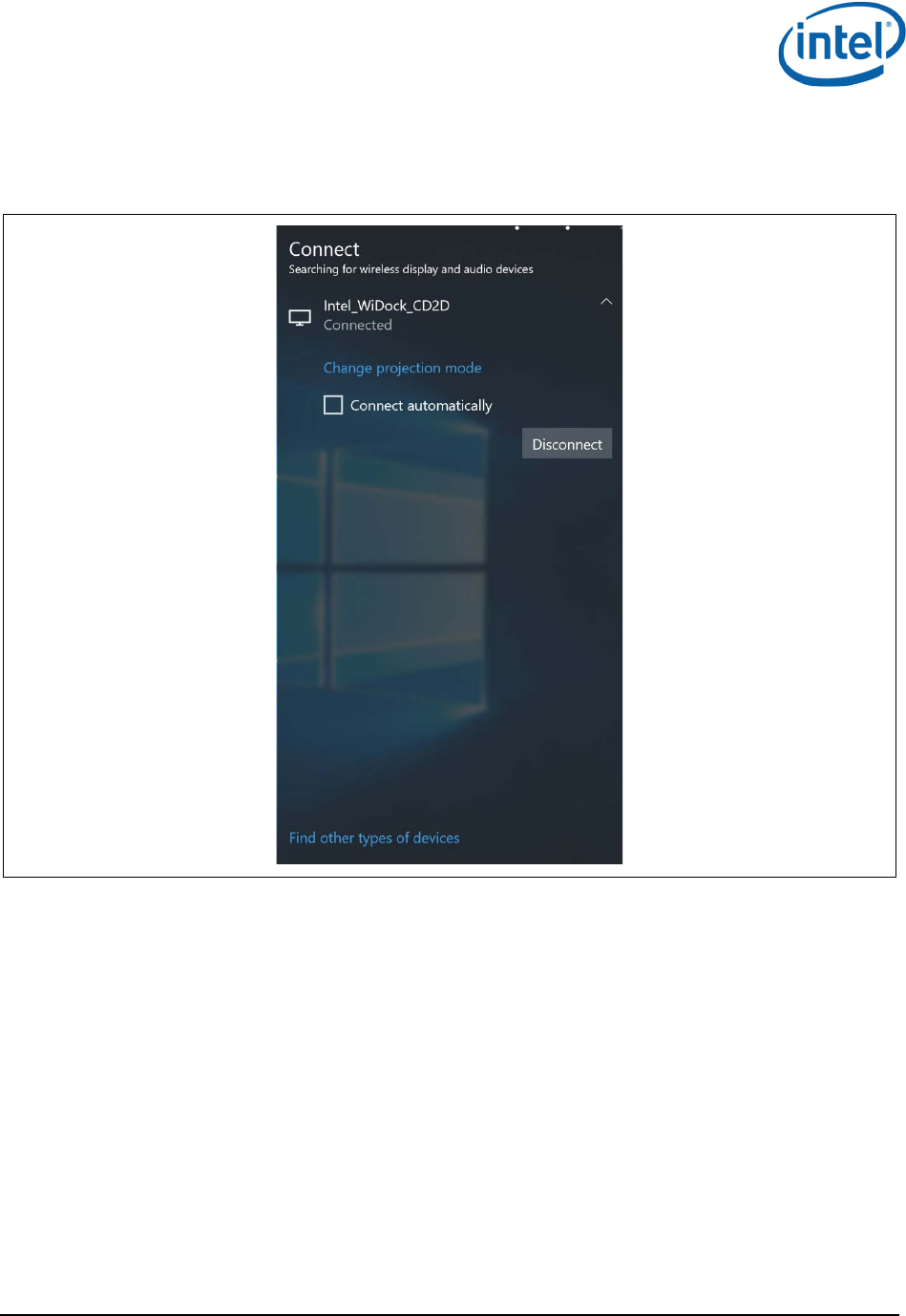
WiGig Application User Manual for Windows 10*
Intel® Wireless Gigabit v2.6
User Guide May 2016
42 Intel Confidential Document Number: 537178-3.9
You can disable auto connect by deselecting the Connect automatically check box while connected, as
shown in Figure 4-9.
Figure 4-9 Disable the auto connect setting
You can change a dock between automatic and manual connection only when you are actively
connected to the dock.
Once auto-connect is disabled, the client no longer connects automatically, and you have to manually
select the dock from the client as described in Section 3.1.5.
4.1.5 Manually connect to a dock
When the dock is defined as manual, the connection is done similarly to the connection flow that was
describe above, without the stage where the user is requested to push the button.
4.1.6 Automatic connection in S3 (depends on BIOS
configuration)
Same as in Section 3.1.6.
4.1.7 Automatic connection in connected standby
Same as in Section 3.1.7.
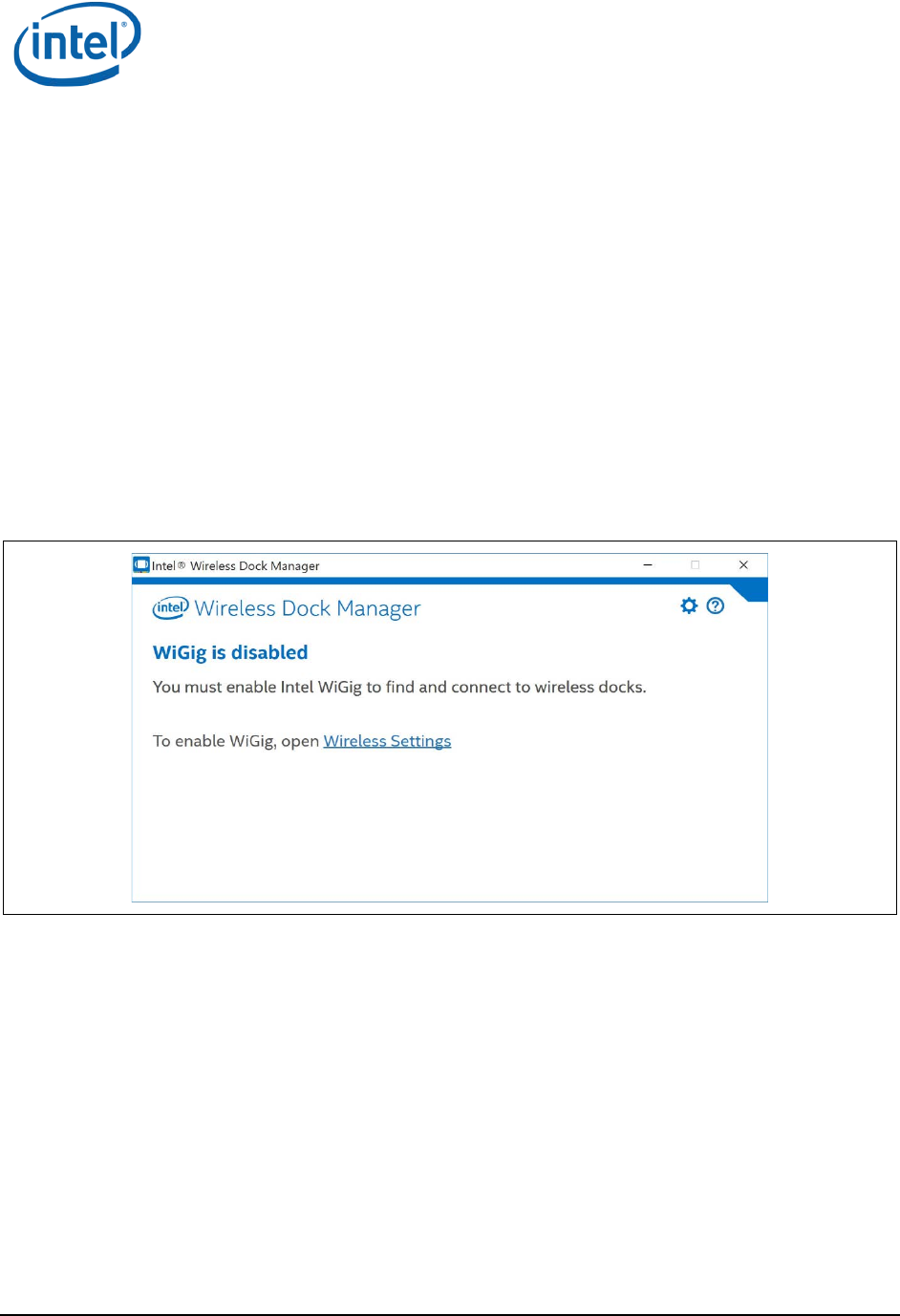
WiGig Application User Manual for Windows 10*
Intel® Wireless Gigabit v2.6
May 2016 User Guide
Document Number: 537178-3.9 Intel Confidential 43
4.1.8 Disconnect from the dock
Same as in Section 3.1.8.
The only differentiation is that to manually disconnect, the user cannot disconnect from the Intel®
Wireless Dock Manager, but instead has to do it from the Connect pane.
4.1.9 PIN-based pairing
Same as in Section 3.1.9
4.1.10 Disable and enable WiGig
1. In Win10, the ability to disable WiGig is available only from the Windows Airplane mode settings
page (Settings-> Network & Internet -> Airplane mode).
2. When WiGig is disabled, you cannot find and connect to wireless docks; the screen shown in
Figure 4-10 comes up in case the Intel® Wireless Dock Manager is open. Disabling minimizes the
power consumption of the WiGig radio in the client.
Figure 4-10 WiGig disabled confirmation message
3. To enable WiGig, go to the Airplane mode settings page by clicking the Wireless Settings link or by
clicking Settings -> Network & Internet -> Airplane mode and turning on WiGig.
4.2 Change dock settings
Same as in Section 3.2.
4.3 Dock software update
Your dock software can be upgraded over the air, from the client.
1. When connecting to the dock, the Wireless Dock Manager might inform the user of mandatory
dock software update.
2. For mandatory dock software updates, you will get a toast notifying you that the dock update is
required, as shown in Figure 4-11.
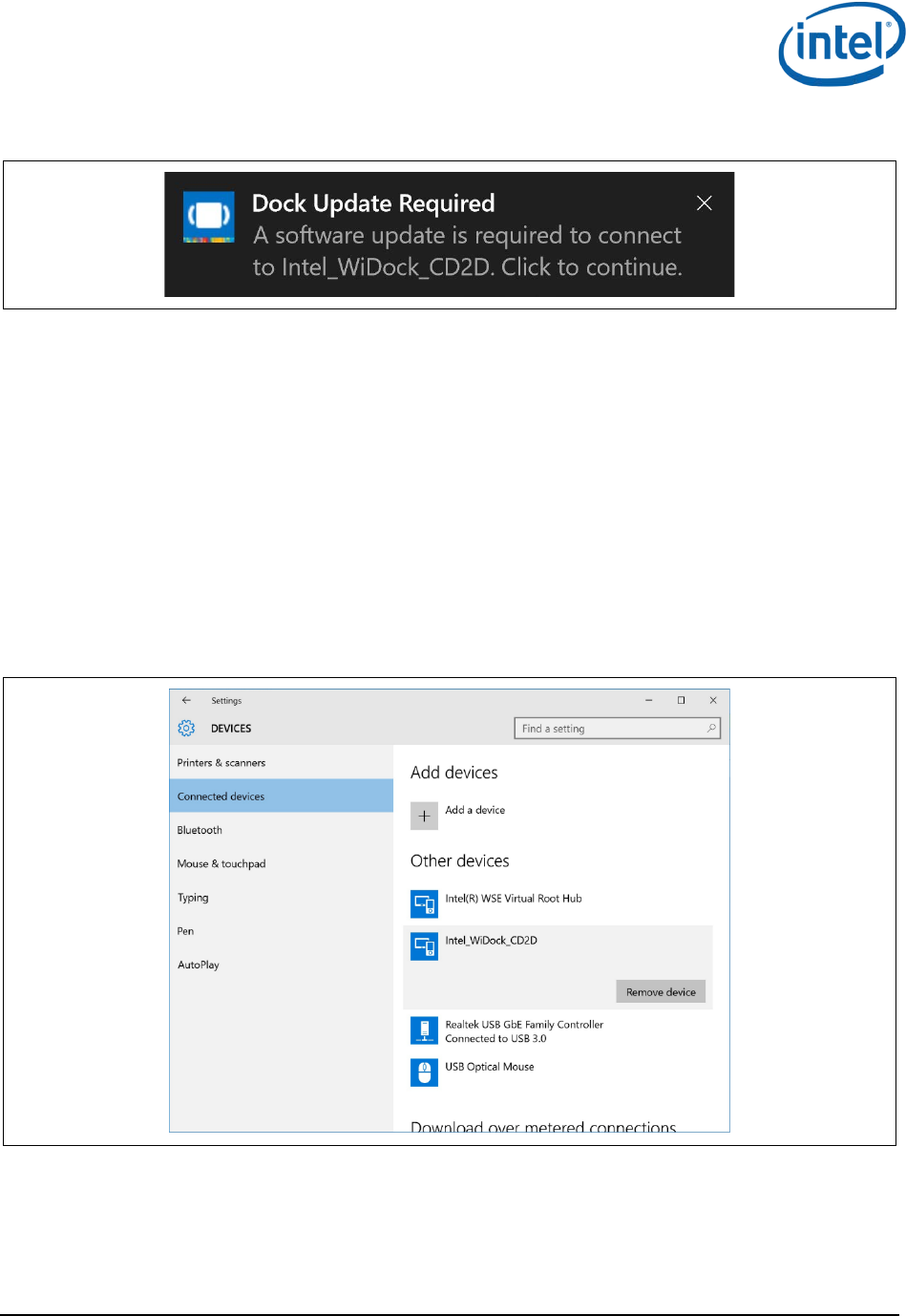
WiGig Application User Manual for Windows 10*
Intel® Wireless Gigabit v2.6
User Guide May 2016
44 Intel Confidential Document Number: 537178-3.9
Figure 4-11 Dock update required toast
3. Clicking on this toast will pop up the Intel® Wireless Dock Manager application.
4. From this point forward, the process of updating the dock is similar to the process described in
Section 3.3.
4.4 Diagnostic information
Same as in Section 3.4.
4.5 Manage docks
User may delete connected docks that are no longer needed.
1. To delete docks, go to Connected devices (Settings ->Devices -> Connected devices), click on the
dock you want to remove, and then click the Remove device button, as shown in Figure 4-12.
Then, you can approve it as shown in Figure 4-13.
Figure 4-12 Remove device button
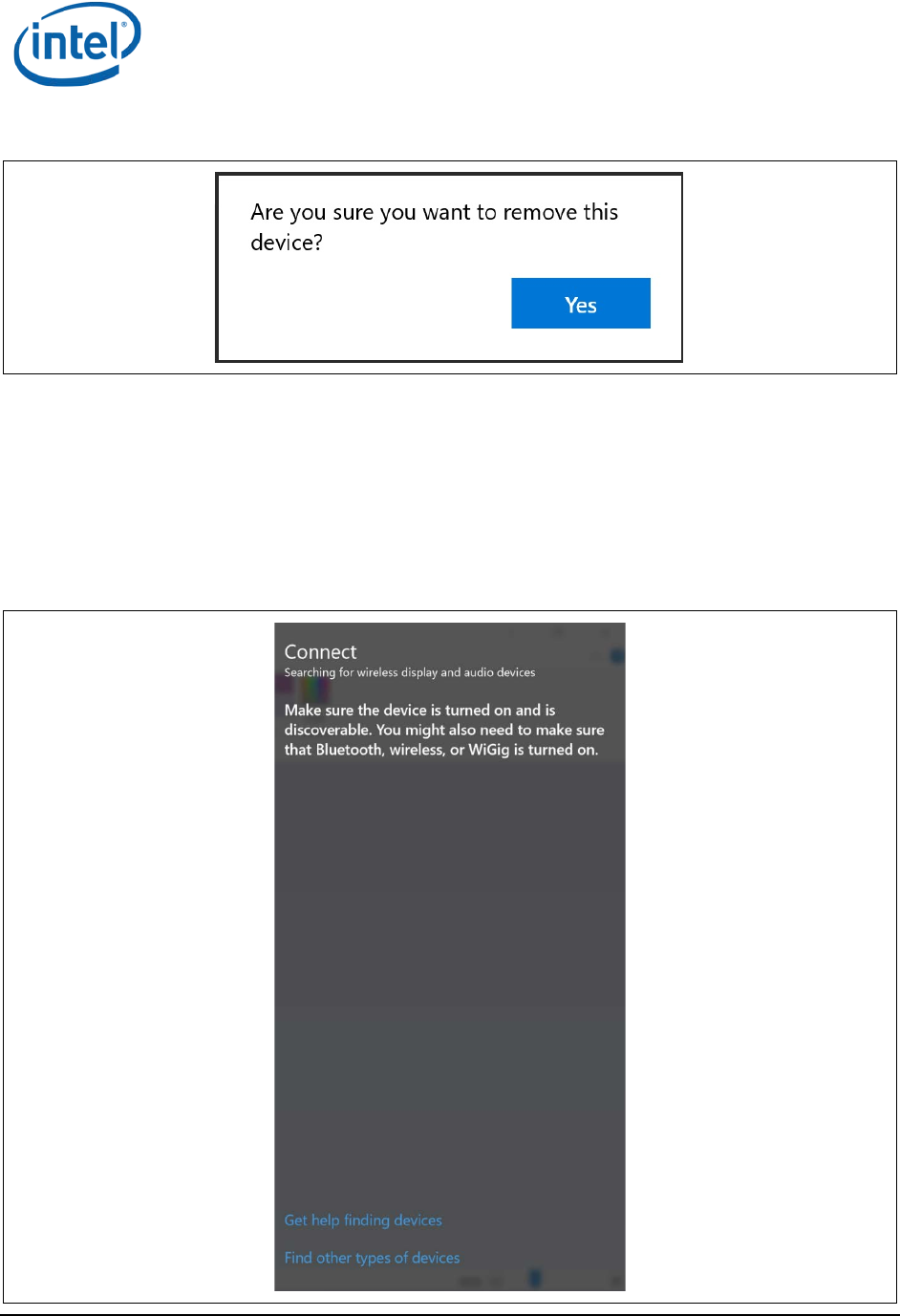
WiGig Application User Manual for Windows 10*
Intel® Wireless Gigabit v2.6
May 2016 User Guide
Document Number: 537178-3.9 Intel Confidential 45
Figure 4-13 Remove device approval dialog box
4.6 Notification messages
This section lists the messages that show possible device limitations or errors.
4.6.1 Not found
When no device can be found, the Connect pane appears with a request to verify that the RF is on, as
shown in Figure 4-14.
Figure 4-14 Device not found message
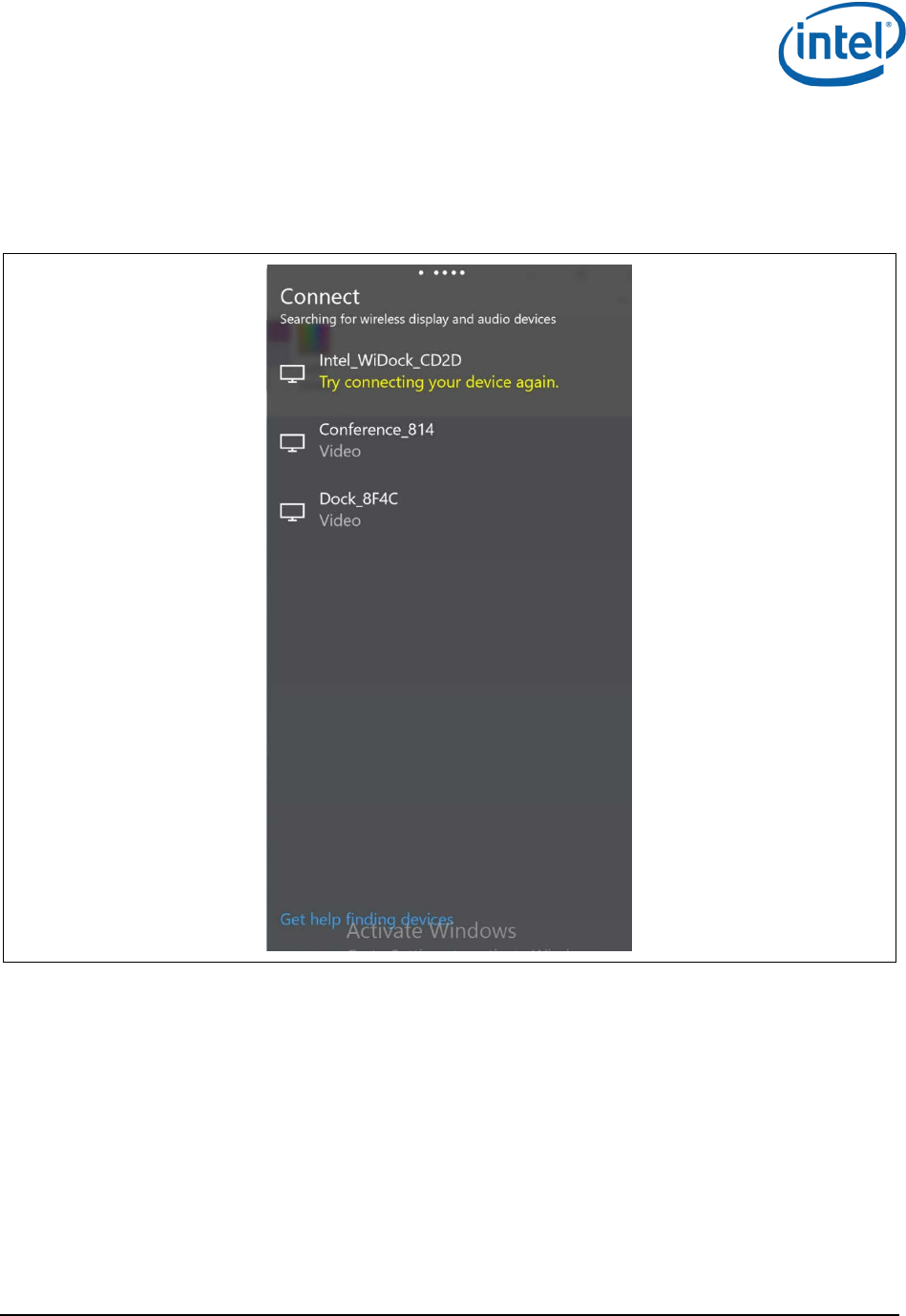
WiGig Application User Manual for Windows 10*
Intel® Wireless Gigabit v2.6
User Guide May 2016
46 Intel Confidential Document Number: 537178-3.9
4.6.2 Try connecting your device again
When there is a problem in the pairing flow (before the user has the dock profile) the Connect pane
returns the error “Try connecting your device again”, as shown in Figure 4-15.
Figure 4-15 Try connecting your device again message
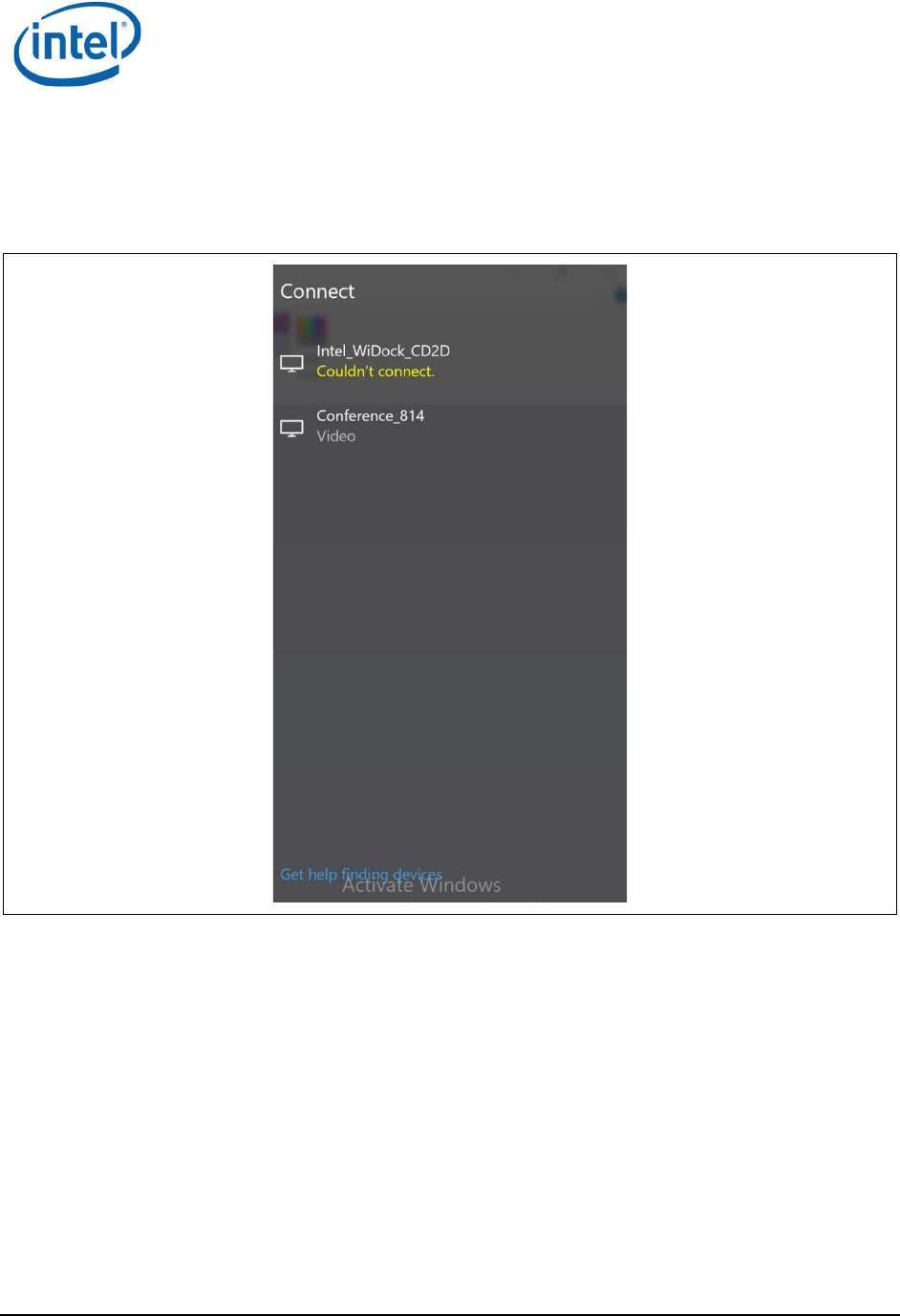
WiGig Application User Manual for Windows 10*
Intel® Wireless Gigabit v2.6
May 2016 User Guide
Document Number: 537178-3.9 Intel Confidential 47
4.6.3 Couldn’t connect
When there is a problem in the connecting flow (after the user has the dock profile), the Connect pane
returns the error “Couldn’t connect”, as shown in Figure 4-16.
Figure 4-16 Couldn’t connect message
4.6.4 Weak connection
The weak connection message displays if the connection is weak, as shown in Figure 4-17. If the
Intel® Wireless Dock Manager application is open, it also notifies the user about this state, as shown in
Figure 4-18.
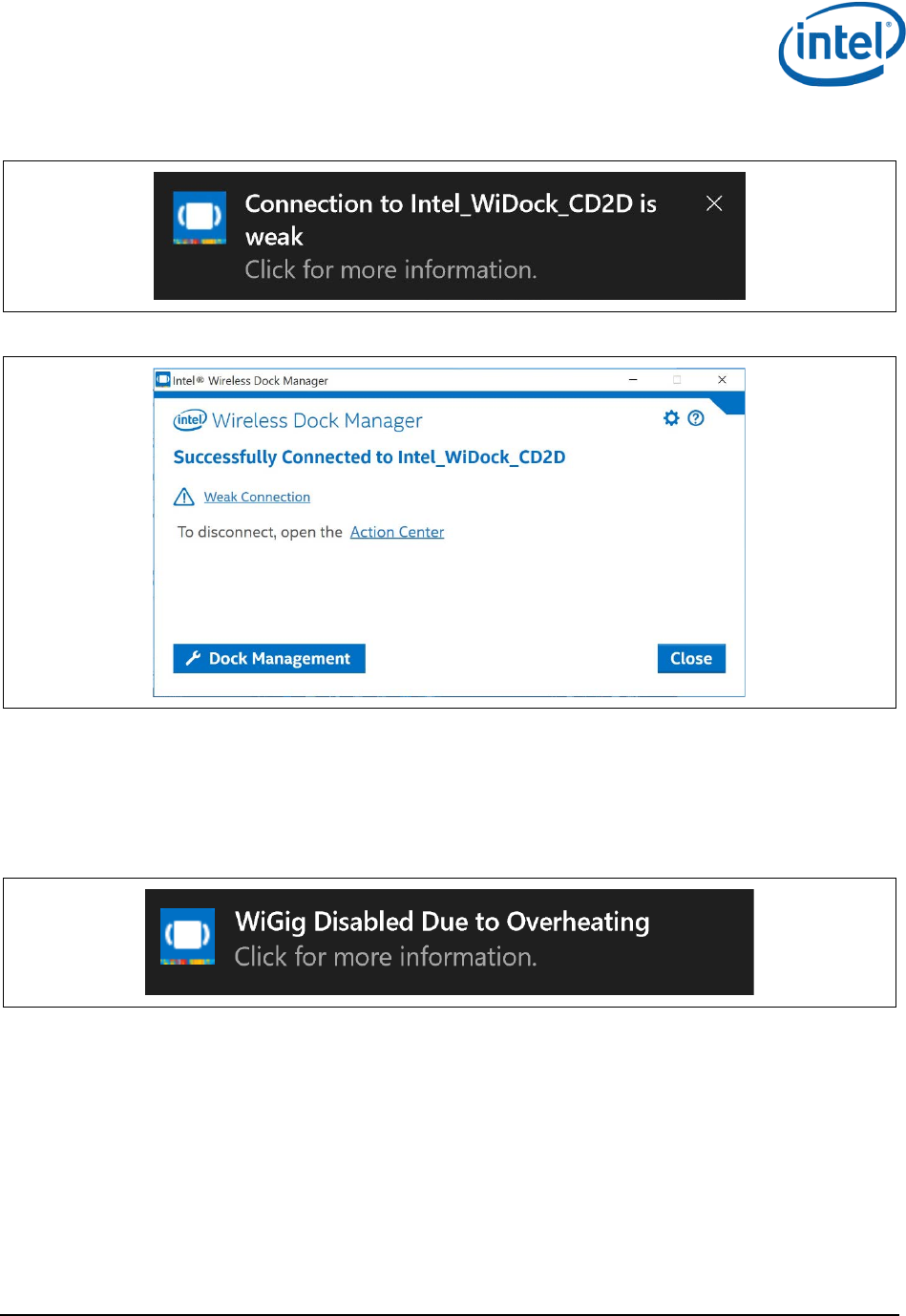
WiGig Application User Manual for Windows 10*
Intel® Wireless Gigabit v2.6
User Guide May 2016
48 Intel Confidential Document Number: 537178-3.9
Figure 4-17 Weak connection toast
Figure 4-18 Weak connection message in Dock Manager
4.6.5 WiGig disabled: critical temperature
When the WiGig is disabled due to overheating, the message shown in Figure 4-19 will popup. Also,
when the Intel® Wireless Dock Manager application is open it will notify the user about this state, as
shown in Figure 4-20.
Figure 4-19 WiGig disabled due to overheating toast

The Wireless Dock and Multiple Displays
Intel® Wireless Gigabit v2.6
User Guide May 2016
50 Intel Confidential Document Number: 537178-3.9
5 The Wireless Dock and Multiple
Displays
5.1 Intel® WiGig A/V wireless capabilities
Intel® WiGig is seen by the Intel® Display Driver as a DP V1.2 Branch device. It advertises its
capabilities to the driver using standard DisplayPort V1.2a tools.
The capabilities include A/V bandwidth, as well as other capabilities related to the internal A/V
subsystem.
Intel® WiGig HW can support up to two A/V streams. This limitation is advertised to the Intel
DisplayPort Driver, which then limits the number of active streams sent over the Intel® WiGig DP
interface.
When the user connects three displays to the MST hub at the output of the Intel® WiGig-based dock,
only two out of the three displays connected can be active at the same time.
5.1.1 Intel® WiGig DisplayPort Bandwidth and other limitations
The DisplayPort V1.2a standard defines mechanisms that allow branch devices to advertise their
capabilities and limitations to the Display Driver. There are two main limitations which may affect the
user experience:
1. DisplayPort Bandwidth (AKA PBN): Intel® WiGig DP interface operates at 4 × 2.7 gbps speed.
This results in an ability to support single display resolutions of up to 2560×1600@60 Hz or Dual
Display Resolutions of 1920×1200@60 Hz.
For example, if the user connects 2 1600p60 capable displays to the dock, it cannot drive the
native resolution to both displays due to the DP BW limitation. The Display Driver will remove
some of the video modes from one of the displays while allowing native resolution to the 2nd
display.
2. Wireless Branch Device Limitations (AKA CCS): Intel® WiGig DP interface advertises Wireless
Branch Device limitations related to the capabilities of the integrated video Encoders and
Decoders.
Currently the advertised limitations are as follows:
a. Frame Width <= 2560
b. Frame Height <= 1600
c. Max Frame Rate = 60 Hz
d. Min Frame Rate = 59 Hz
e. Max Pixel Clock = 268 MHz
f. RGB: Only color space modes supported
g. Progressive only modes supported
All display modes not meeting the criteria above will be removed by the display driver and not
shown by the Resolution Manager.
5.2 User experience when connecting more than two
displays to the wireless dock
The driver initially selects two default displays. These will be the displays connected to the output
ports #1 and #2 of the MST hub device. The display connected to port #3 will not be used and will not
appear in the Windows Screen Resolution control panel.
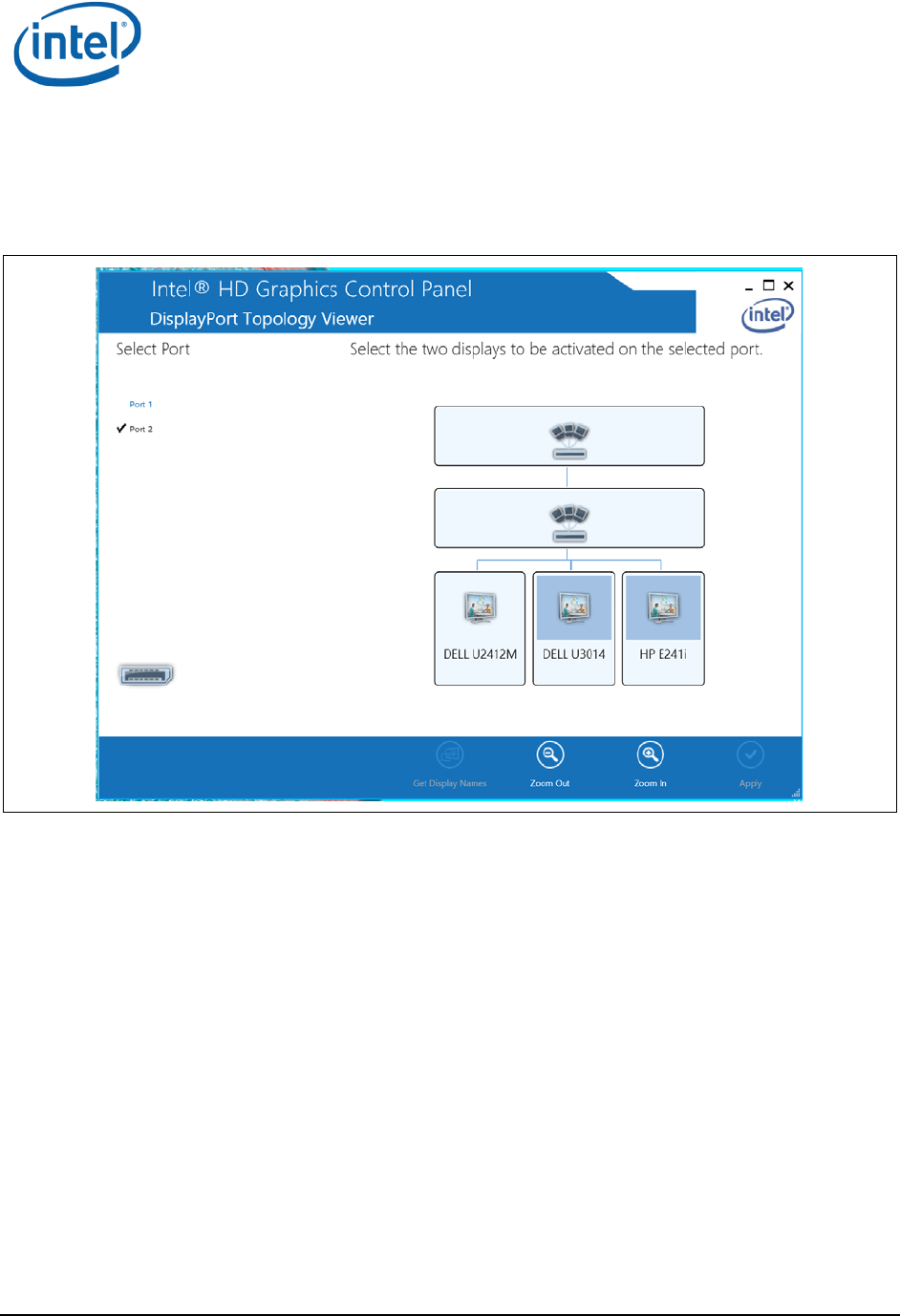
The Wireless Dock and Multiple Displays
Intel® Wireless Gigabit v2.6
May 2016 User Guide
Document Number: 537178-3.9 Intel Confidential 51
The Intel® Display Driver generates a pop-up window, stating “DisplayPort Topology Notification. A
new DisplayPort Topology has been identified”. Click the window to open the Intel® HD Graphics
control panel’s DisplayPort Topology Viewer (see Figure 5-1). The user is requested to select the two
displays to be activated for the Intel® WiGig selected port. Selected displays are marked in light blue.
Figure 5-1 DisplayPort topology viewer
Once the user selects the active displays, the display driver will re-initiate the A/V link setup process
and activate the selected displays.
Only the selected displays will be seen in the Windows Screen Resolution control panel. The
unselected display will not be shown (see Figure 5-2). The user can select the operating mode
(duplicate/extend), and activate and deactivate the screens using the Screen Resolution control panel.
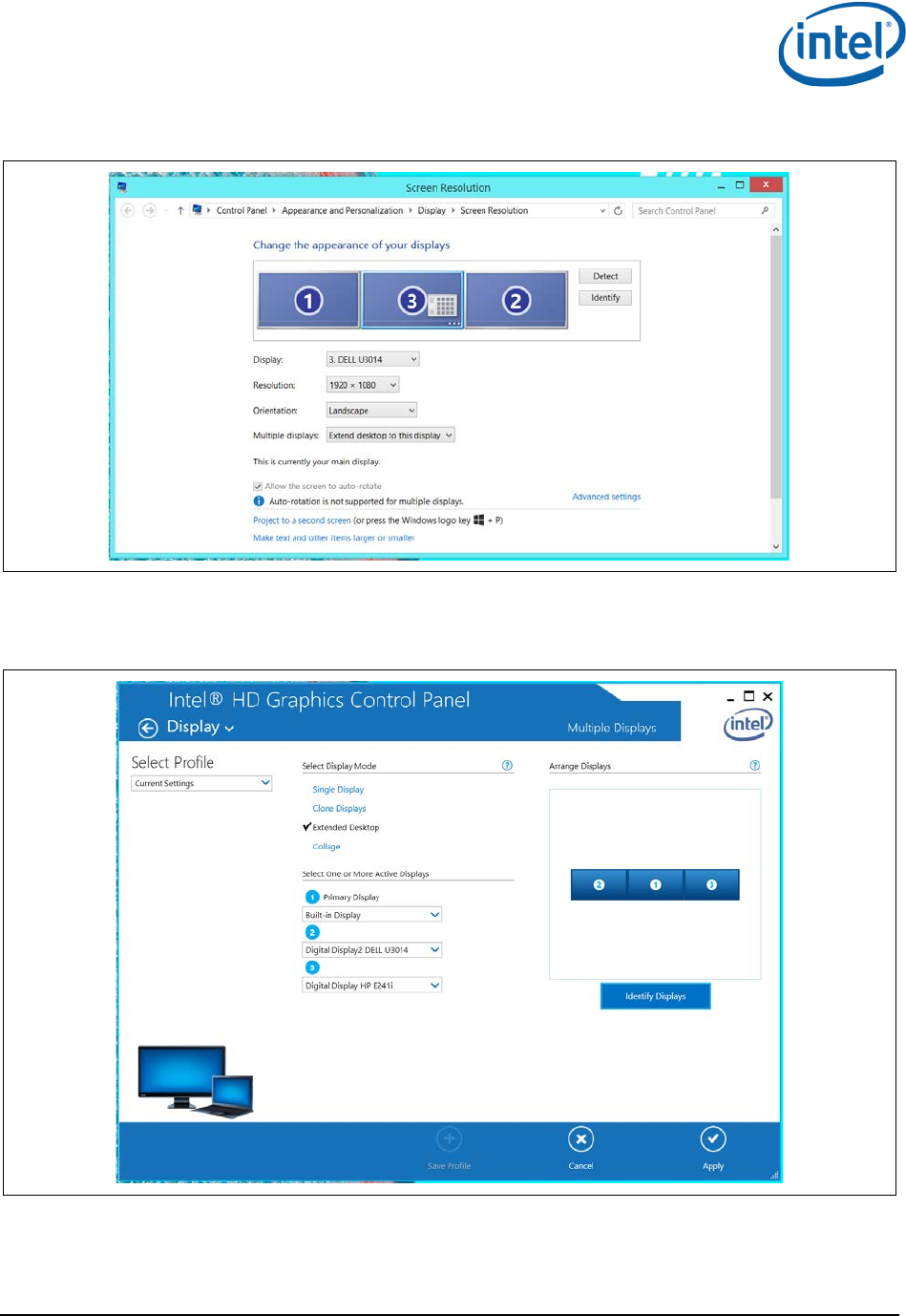
The Wireless Dock and Multiple Displays
Intel® Wireless Gigabit v2.6
User Guide May 2016
52 Intel Confidential Document Number: 537178-3.9
Figure 5-2 Windows Screen Resolution control panel
The same behavior occurs when the user uses the Intel® Graphics Control Panel’s Display tab (see
Figure 5-3). In this window, only the two displays selected in the Topology Manager will be seen.
Figure 5-3 Graphics control panel
§

WiGig events in Windows Event Viewer
Intel® Wireless Gigabit v2.6
May 2016 User Guide
Document Number: 537178-3.9 Intel Confidential 53
6 WiGig events in Windows Event
Viewer
WiGig SW provides logging information to Windows Event Viewer, both for local client machine and for
the connected WiGig dock. This information appears in Windows Event Viewer under Applications and
Services Logs -> Intel® WiGig.
6.1 WiGig Event Properties
The events are distinguished by the following list of properties:
• Log Name: Intel® WiGiG
• Level: can be
o Information – Events with this level provides informative data of WiGig flow.
o Error - Event with this level provides data for erroneous WiGig flow.
• Source: can be
o iWiGig-Local – Events logged from local Client side
o iWiGig-Remote – Events logged from remote Docking side, that is, WiGig connected to
the Client
• Event ID: Will be always 256
• Task Category: The index for this parameter may belong to the groups listed in Table 6–1.
Table 6–1 List of groups for Task Category parameter in WiGig Events
Task Category index range Group type
1 0-199 General Infra & Platform Events
2 200-299 Dock FW-Update Events
3 300-399 MAUSB Events
4 600-699 WDE Events
6.2 WiGig Event Data
The data per each event provides the following information:
• Release: WiGig SW release version
• Self MAC Address: WiGig MAC Address value of Client side
• Peer MAC Address: WiGig MAC Address of connected peer docking station
• The next information presented is low-level debug data, per each event.
6.3 Accessing WiGig Events Log
The steps to access the WiGig Events log are
1. Open the Windows Event Viewer.

WiGig events in Windows Event Viewer
Intel® Wireless Gigabit v2.6
User Guide May 2016
54 Intel Confidential Document Number: 537178-3.9
2. On the left-hand pane, Go to Applications and Services Logs->Intel® WiGig.
The middle pane displays the list of WiGig events.
3. The user can click on each event and see its specific details on the bottom pane.
4. By right-clicking on Applications and Services Logs->Intel® WiGig (on the left-hand pane),
user may save the WiGig Events log or perform other operations as allowed by the Event
Viewer.
